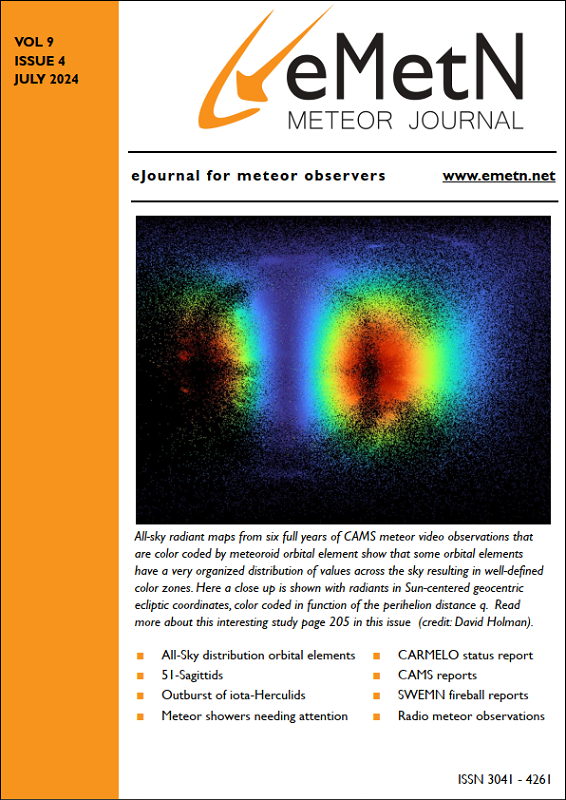Abstract: We attempted to numerically evaluate the reports published in the Shower Database, SD (downloaded 2023 on March 29) using GMN video observation data (downloaded 2023 on February 25). Of the 1595 entries published in the SD, 1117 were investigated, excluding those from the same group or those with insufficient data. There were 67 entries that were evaluated to have been clearly captured by video observation (Grade 10 and 9), 147 where the existence could be confirmed (Grade 8 and 7), and 213 where further confirmation work was required (Grade 6 and 5). On the other hand, for 339 entries, no corresponding meteor shower could be found (Grade 4); 201 where the observed meteors are so small (N<10) and cannot be checked (Grade 3). In this survey, there were 78 cases in which it was impossible to investigate areas surrounding powerful meteor showers (Grade 2). There were also 99 cases that were determined to be duplicates of those that had already been reported (Grade 1).
It is highly anticipated that future GMN observations will help a lot clarifying the problems, especially in the southern hemisphere.
1 Introduction
The Shower Database (SD) list is a mixed bag, and the data posted cannot be taken as exact facts. Early publications included only visual observations or were based on a few orbits from photographic or radio observations. For example, 0300ZPU00 ~ 0318MVE00 are not numbered in the original SD, that is, in Jenniskens (2006), and are based on visual observations. Since then, many meteor showers have been discovered by using the rich data from radio and video observations. On the other hand, there are also claims for meteor shower discoveries which are so weak that it is indistinguishable from the sporadic background meteor activity. Furthermore, the SD has a problem with multiple shower activities which are included in one meteor shower, or conversely, the same activity is registered as a different meteor shower (Koseki, 2020a).
In response to this confusion, it would be meaningful to evaluate how relevant the individual reports published in the SD can be considered. It is best to use Global Meteor Network data as GMN has sufficient video observations publicly available for this purpose.
2 Research step
2.1 Selection of the entries
We use the SD downloaded 2023 on March 29, which has 1595 entries. It is not necessary to survey all entries because this research intends to estimate the grade for each meteor shower. In fact, we made selections while looking at the radiant point distribution and the activity curve for the next step excluding 0290ALL00 ~ 0299OAR00 because they lack radiant data, and ultimately investigated 1117 out of 1595 entries. In this way, we use IAUNo + Code + AdNo as the CODE for distinguishing the entries in the same meteor shower, for example, 0023EGE00 for describing the first entry of EGE (epsilon-Geminids).
2.2 Plotting the radiant distribution of GMN meteors and the activity profile
Koseki (2019a) showed it is useful for us to plot the radiant distribution 10 degrees in solar longitude before and after the maximum listed in the entry and to calculate DRs: the sliding mean of the radiant density ratios within bins of 3 degrees in λʘ.
- DR3: the density ratio within a circle of 3 degrees relative to a ring of 3 to 6 degrees.
- DR10: the density ratio within a circle of 3 degrees relative to a ring of 6 to 10 degrees.
- DR15: the density ratio within a circle of 3 degrees relative to a ring of 10 to 15 degrees.
- DR3_20: the density ratio within a circle of 3 degrees relative to a ring of 15 to 20 degrees.
- DR6_20: the density ratio within a circle of 6 degrees relative to a ring of 15 to 20 degrees; this is only a reference value.
- DR = 1 means that the radiant density is flat.
Figures 1 to 3 and Tables 1 and 2 are examples of this procedure for 0023EGE00. Figure 1 shows the radiant distribution of GMN video meteors around (λ – λʘ, β) = (253.48, 4.20) from λʘ = 199.7° to λʘ = 219.7°; the radiant concentration is well within r < 3 degrees. Figure 2 shows the radiant distribution given in the SD; boxes are classified as EGE and a cross represents others. We can judge whether the classification in the SD is adequate. If inadequate, we divide such entries into several groups. If some crosses are in the inner circle (r < 3), we should be cautious about whether they might be an indication for other, different, shower activities. Table 1 gives some details of meteor activities plotted in Figure 2. Figure 3 represents the activity profiles plotted according to the calculation of DRs and Nr ≤ 3; DR3_20 and DR6_20 are omitted to simplify the figure; the graph for Nr ≤ 3 represents the number of radiants counted within 3 degrees from the radiant position in steps of one degree in λʘ. The graph of DR15 is quite different from the other three because the nearby strong activity of Orionids hinders DR15 of EGE.
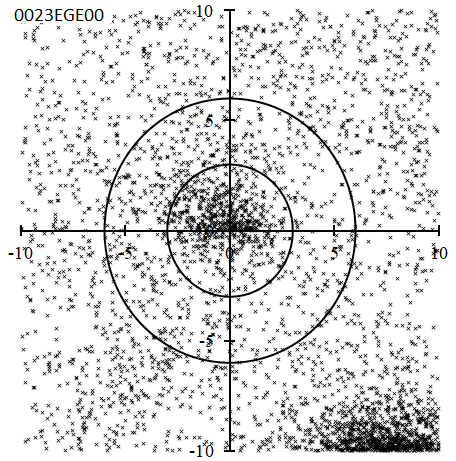
Figure 1 – Radiant distribution for 0023EGE03. The center is (λ – λʘ, β) = (253.48, 4.20) and the period is λʘ = 199.7° to λʘ = 219.7°. The radius of the inner circle is 3 degrees and the radius of the outer circle is 6 degrees, and the EGE radiants fall within the inner circle.

Figure 2 – Radiant distribution for meteor showers listed in the SD; the center and range are the same as in Figure 1. Filled squares are EGE, and one cross is the other.
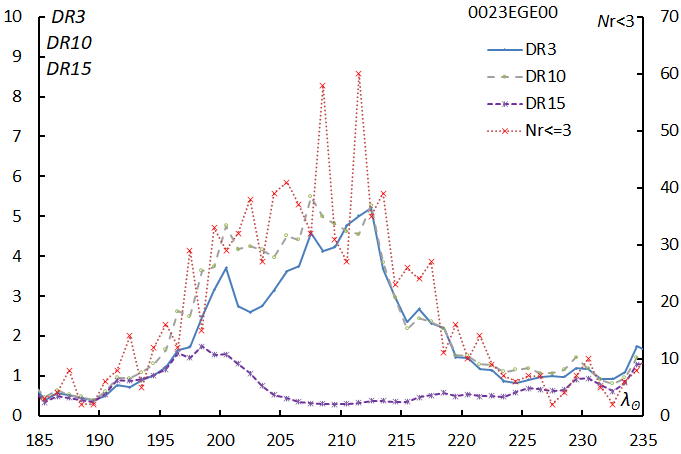
Figure 3 – Activity profiles of EGE using DR; the center used for calculation is the same as in Figure 1.
Table 1 – The radiant distribution near the EGE shower activities in the SD.
| CODE | λʘ | λ – λʘ | β | vg | Distance | x | y |
| 0023EGE00 | 209.7 | 253.48 | 4.2 | 69.4 | 0 | 0 | 0 |
| 0023EGE01 | 206 | 254.37 | 3.68 | 68.8 | 1 | –0.9 | –0.5 |
| 0023EGE02 | 198 | 255.36 | 4.71 | 69.6 | 1.9 | –1.9 | 0.5 |
| 0537KAU00 | 208 | 244.63 | 9.79 | 65.5 | 10.4 | 8.7 | 5.7 |
Table 2 – The peak values of the graphs in Figure 3; DR3_20 and DR6_20 are added and N3 gives the total meteor number within r ≤ 3 and λʘ = 199.7~219.7°.
| λʘ | Value | |
| Nr ≤ 3 | 211.5 | 60 |
| DR3 | 212.5 | 5.22 |
| DR10 | 207.5 | 5.49 |
| DR15 | 200.5 | 1.54 |
| DR3_20 | 200.5 | 4.61 |
| DR6_20 | 202.5 | 2.35 |
| N3 | 657 |
2.3 Check the peak rates of the raw number and the DR
When evaluating meteor showers, it is important that the radiant point and maximum activity are clearly defined. It seems useful to give another example to confirm the meaning of DRs and Nr ≤ 3.
Figures 4 and 5 show the radiant distribution and the activity profiles for 0022LMI03 and Table 3 gives the summary of its activity.
It is clear the radiants of LMI are concentrated within narrow areas and surrounding meteor activities are scarce. As a result, it can be seen that the values of DRs become larger and the variation in the maximum becomes smaller than those of EGE though N3 of LMI is smaller than EGE, that is, the total LMI activity is smaller than EGE. Therefore, the density of radiant points and the intensity of the meteor shower activity can be expressed by the magnitude of the DR values. On the other hand, it must be noted that in cases such as EGE, where the meteor shower is affected by surrounding meteor showers, Nr ≤ 3 is a direct indicator of the strength of the meteor shower’s activity.
Table 3 – Summary of the LMI activity profile (Figure 5).
| λʘ | Value | |
| Nr ≤ 3 | 208.5 | 125 |
| DR3 | 210.5 | 27.62 |
| DR10 | 208.5 | 55.17 |
| DR15 | 207.5 | 54.32 |
| DR3_20 | 209.5 | 29.01 |
| DR6_20 | 209.5 | 8.12 |
| N3 | 827 |
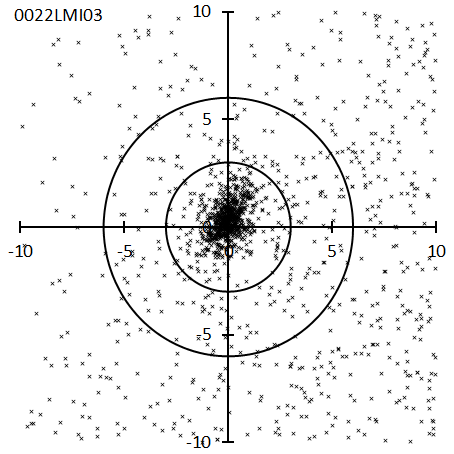
Figure 4 – Radiant distribution for 0022LMI03. The center is (λ – λʘ, β) = (297.96, 25.93) and the period is λʘ = 199° to λʘ = 219°. Compared to EGE, the radiant points are concentrated, and the surrounding radiant point distribution is diffused.
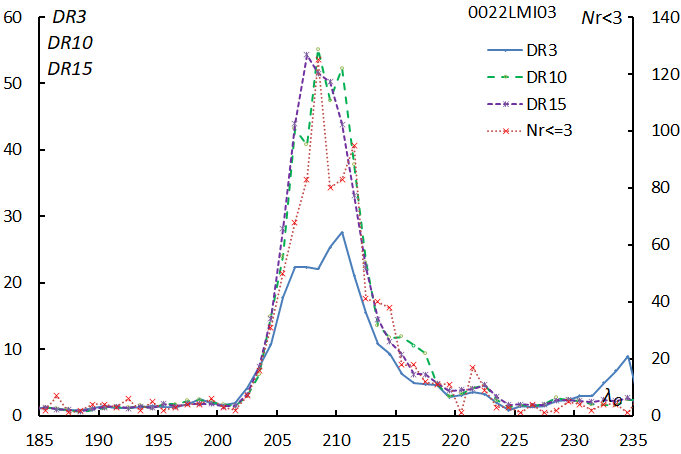
Figure 5 – Activity profiles of LMI using DR; the center used for calculation is the same as in Figure 4. The activity curves are narrower and higher than those of EGE.
2.4 Evaluation of the grading
There are three other issues when evaluating meteor shower activity.
Firstly, as is clear from the maps in the appendix, meteor showers around the Sun and deep in the southern hemisphere are difficult to observe with GMN video observations; that is, they have N3 < 10. Second, the method used here is not applicable around strong meteor showers. To handle such meteor showers, it is necessary to use specialized methods, so they are excluded from this study. The third problem is confusion in the SD itself, where the same meteor shower is listed separately, or different meteor showers are listed in one item. Taking these issues into consideration, meteor shower activity is evaluated on the following 10 scales. Below, the average value of DRs (excluded DR6_20 because this is only a reference value) is abbreviated as DR, and Nr ≤ 3 is abbreviated as N. Figure 6 shows the summary of the evaluation.
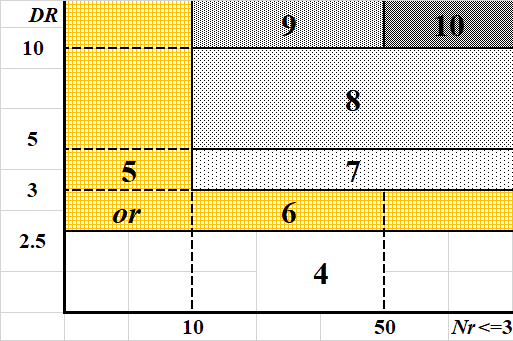
Figure 6 – Overview of the evalution for the classification in different Grades.
The grading criteria:
- 10: DR> 10 and N > 50, 39 cases.
- 9: DR> 10 and 10 < N < 50, 28 cases.
- 8: DR> 5 and N > 10, 53 cases.
- 7: DR> 3 and N > 10, 94 cases.
- 5 and 6: DR> 2.5. If the difference between the date of the maximum listed in the SD and the average date of the maximum for DR is less than 5, the score is 6 else 5. 159 cases got Grade 6, 54 cases Grade 5.
- 4: DR < 2.5, 339 cases.
- 3: N3< 10, 201 cases.
- 2: In case a strong shower (STA and NTA, ORI (with its tale; TORI), PER, GEM, COM, and SDA) influences the radiant area, 78 cases.
- 1: When there is confusion in the SD, 72 cases.
2.5 Preliminary grading of meteor showers listed in the SD
Although this evaluation is provisional as it does not consider the radiant point’s drift, we believe it will be useful for readers. If the rating is not 9 or higher, it cannot be a target for visual observation, a rating of 8 can only be captured under favorable conditions. It is appropriate to limit meteor showers to those of 7 or higher levels when we count the number of meteors and investigate the properties of meteor showers. Those with a stage of 4 or lower are those whose activity was not confirmed in this survey, and those with a stage of 5 and 6 require future investigation and consideration, including whether they exist as a meteor shower. The number of cases for each grade has been mentioned above with the grading criteria.
2.6 Classification of meteor showers
The number following the slash after the Code is the value of the ‘shower status flags’ by the SD. Particularly established showers are shown in bold in the list.
The shower status flags:
- –9: removed from the MDC, data not published
- –8: no Look up table
- –7: various faults: typo, suspicious …
- –6: criterion R3; the shower has been found to be unreliable.
- –5: not used yet
- –4: criterion R2; duplicate, shower designation was changed; the data was added as another solution to the previously known stream
- –3: criterion R4; N< 3; only 1 or 2 members
- –2: criterion R1; missing or wrong data, or problems with references
- –1: to be removed from the list of established showers
- 0: single shower, working list
- 1: single established shower,
- 2: to be established shower
Criteria for moving showers to the List of removed showers (Hajduková et al., 2023):
- R1. The correct bibliographic information for the stream identification is absent.
- R2. The shower is found to be a duplicate of an earlier discovered shower.
- R3. The shower has been found to be unreliable.
- R4. The stream was identified using fewer than three meteoroids.
Meteor showers marked with * in parentheses have comments in the section Additional notes below, so please refer to the corresponding Code in this section. If * is followed by a different Code, please see the comments for that Code. For Grade 2, the meteor shower that had an influence is indicated by an abbreviation in parentheses; TORI means the tail of Orionids.
Grade 10
0001CAP06/1(*), 0002STA00/1, 0004GEM00/1, 0005SDA00/1, 0006LYR00/1, 0007PER00/1, 0008ORI00/1, 0010QUA00/1, 0011EVI06/1(*), 0012KCG11/1(*), 0013LEO00/1, 0015URS01/–2, 0016HYD01/1, 0017NTA03/1, 0019MON01/1, 0020COM03/1, 0022LMI03/1, 0026NDA10/1, 0031ETA07/1, 0145ELY02/1, 0164NZC01/1(*0164NZC00), 0175JPE02/1, 0184GDR00/1, 0191ERI02/1, 0199ADC01/0, 0208SPE02/1(*), 0250NOO06/1, 0281OCT00/1, 0333OCU00/1, 0336DKD01/1, 0341XUM06/1, 0404GUM04/1, 0411CAN00/1, 0429ACB00/2, 0431JIP00/1(*0367OPG00), 0444ZCS00/2, 0445KUM00/1, 0458JEC00/0, 0623XCS00/0(*).
Grade 9
0018AND01/1, 0027KSE01/–3, 0027KSE02/1(*), 0110AAN04/1, 0164NZC00/1(*), 0165SZC02/1(*), 0170JBO07/1, 0171ARI03/1, 0221DSX00/1, 0255PUV00/–2(*), 0323XCB04/1, 0331AHY00/1, 0335XVI00/1(*), 0343HVI07/1, 0362JMC02/1, 0370MIC00/0(*0165SZC02), 0372PPS00/1(*), 0410DPI00/0, 0428DSV00/1(*), 0450AED00/0, 0497DAB00/0, 0510JRC00/1, 0533JXA00/1(*), 0569OHY00/1(*0316BHD00), 0757CCY00/0, 0784KVE00/0(*0303LVL00), 0839PSR00/0(*0027KSE02), 0860PAN00/0.
Grade 8
0021AVB06/1(*), 0040ZCY02/2(*), 0069SSG03/1, 0081SLY00/0(*), 0187PCA00/1(*), 0197AUD01/1(*0073ZDR00), 0206AUR03/1, 0215NPI04/2(*), 0246AMO00/1(*), 0257ORS03/1(*), 0319JLE00/1, 0334DAD00/1(*), 0337NUE00/1(*), 0338OER00/1(*), 0339PSU01/1, 0340TPY00/0(*), 0340TPY01/0(*), 0346XHE01/1, 0348ARC00/1, 0372PPS01/1(*0372PPS00), 0394ACA00/2, 0427FED00/1, 0459JEO01/0, 0465AXC00/0, 0480TCA00/0(*), 0481OML00/0, 0488NSU00/0(*0527UUM00), 0490DGE01/0(*), 0502DRV00/2(*), 0512RPU00/1, 0515OLE00/0(*), 0519BAQ00/2, 0520MBC00/0, 0523AGC00/2, 0524LUM00/1, 0526SLD00/1, 0529EHY00/1, 0531GAQ01/2, 0552PSO01/2(*), 0571TSB00/0, 0647BCO00/0, 0694OMG00/0(*), 0825XIE00/0, 0841DHE00/0, 0854PCY00/0, 0867FPE00/0(*0371APG00), 0893EOP00/0, 0915DNO00/0, 0924SAN00/0, 1032FHY00/0, 1096NAC00/0, 1133TCS00/0(*0187PCA00), 1166TTR00/0.
Grade 7
0012KCG07/1(*), 0023EGE00/1, 0040ZCY00/2, 0047DLI02/0(*), 0049LVI00/–3, 0055ASC01/–6, 0081SLY01/0(*), 0096NCC00/1(*), 0096NCC02/1(*0096NCC00), 0096NCC03/1(*0096NCC00), 0096NCC06/1(*0096NCC00), 0096NCC08/1(*0096NCC00), 0097SCC03/1(*0096NCC00), 0097SCC05/1(*0096NCC00), 0101PIH00/0, 0136SLE00/0(*), 0139GLI00/0(*), 0149NOP02/0(*0150SOP00), 0150SOP00/0(*), 0150SOP03/0(*0150SOP00), 0150SOP05/0(*0150SOP00), 0167NSS01/0(*), 0168SSS00/0, 0183PAU00/1, 0183PAU02/1, 0197AUD00/1(*0073ZDR00), 0205XAU00/–3, 0253CMI03/0, 0371APG00/0(*), 0386OBC01/2, 0413MUL00/2, 0416SIC00/2, 0436GCP00/0, 0439ASX02/0(*), 0448AAL00/–6(*0139GLI00), 0456MPS00/2(*0150SOP00), 0460LOP00/2, 0464KLY00/0(*), 0470AMD02/2(*), 0472ATA01/–6, 0493DEC00/0, 0507UAN01/0, 0517ALO00/0, 0530ECV00/1(*), 0549FAN00/1, 0556PTA00/0, 0557SFD00/0, 0563DOU00/0(*), 0567XHY00/0(*), 0568FCV00/0, 0570FBH00/0, 0581NHE00/0, 0582JBC00/0, 0587FNC00/0, 0601ICT00/0, 0610SGM00/0, 0644JLL00/0(*), 0645PHC00/0, 0651OAV00/0, 0653RLY00/0, 0665MUC00/0(*0359MZC00), 0686JRD00/0(*), 0708RLM00/0, 0710IOL00/0, 0729DCO00/0, 0738RER00/0(*), 0749NMV00/0(*0710IOL00), 0750SMV00/0, 0803LSA00/0, 0809USG00/0(*0150SOP00), 0814CVD00/0, 0817PCI00/0(*), 0829JSP00/0, 0830SCY00/0, 0833KOR00/0, 0837CAE00/0, 0849SZE00/0, 0874PXS00/0, 0877OHD00/0, 0886ACV00/0, 0891FSL00/0, 0897OUR00/0, 0920XSC00/0(*), 1075AGP00/0(*0817PCI00), 1088SEE00/0, 1093NCB00/0, 1106GAD00/0, 1120DUM00/0, 1131OZP00/0, 1165BCS00/0(*), 1180DAN00/0(*0340TPY01), 1185ESV00/–2, 1189TZA00/0(*), M2023–D2/0(*1099JED00).
Grade 6
0009DRA06/1, 0027KSE00/1, 0061TAH00/1, 0061TAH02/1, 0067NSA00/0, 0093VEL02/–6(*0093VEL00), 0103TCE01/–3, 0134NGV00/0, 0150SOP01/0(*0150SOP00), 0151EAU00/1, 0152NOC04/1(*), 0165SZC01/1(*), 0170JBO00/1, 0186EUM01/0, 0200ESE00/0, 0212KLE00/1, 0220NDR00/2, 0225SOR01/0, 0241OUI00/0, 0245NHD00/–3(*0558TSM00), 0252ALY00/0(*), 0254PHO01/1(*), 0269OCS00/–3, 0275CLI00/–2, 0308PIP00/0, 0313ECR00/0(*), 0324EPR00/1, 0349LLY00/0, 0365BCM00/0, 0395GCM00/0, 0398DCM01/0, 0400BMO00/0, 0414ATR00/0(*), 0446DPC00/1, 0462JGP00/0, 0472ATA00/–6, 0482NGP00/–6, 0491DCC00/0, 0501FPL00/–6, 0535THC00/0, 0536FSO00/0, 0545XCA00/0, 0559MCB00/0, 0575SAU00/0(*), 0580CHA00/0, 0583TTA00/0(*), 0605FHR00/0, 0655APC00/0, 0657GSG00/0, 0658EDR00/0(*), 0661OTH00/0, 0668JMP00/0, 0681OAQ00/0, 0683JTS00/0, 0688BTR00/0, 0689TAC00/0, 0693ANP00/0, 0707BPX00/0, 0709LCM00/0(*0093VEL00), 0709LCM01/0(*0093VEL00), 0712FDC00/0, 0713CCR00/0, 0716OCH00/0, 0720NGB00/0, 0727ISR00/0, 0732FGV00/0, 0734MOC00/0, 0736XIP00/0, 0739LAR00/0, 0752AAC00/0, 0770LCA00/0(*), 0771SCO00/0, 0780NPU00/0(*0761PPC00), 0781NLV00/0(*0761PPC00), 0790PVL00/0, 0795SUR00/0, 0800JCT00/0, 0802ADS00/0, 0807FLO00/0, 0812NAA00/0, 0815UMS00/–7, 0816CVT00/0, 0818OAG00/0, 0822NUT00/0, 0823FCE00/0(*), 0824DEX00/0(*0542DES00), 0826ILI00/0, 0827NPE00/0, 0831GPG00/0, 0834ACU00/0, 0840TER00/0, 0843DMD00/0, 0847BEL00/0, 0848OPE00/0, 0850MBA00/0, 0856EMO00/0, 0859MTB00/0, 0862SSR00/0, 0865JES00/0, 0866ECB00/0, 0870JPG00/0, 0875TEI00/0, 0879ATI00/0, 0880YDR00/0, 0882PLE00/0, 0884NBP00/0, 0887DZB00/0, 0889YOP00/0, 0890ESU00/0, 0892MCN00/0, 0906ETD00/0, 0907MCE00/0, 0917OVI00/0, 0922PPE00/0(*), 0927AAQ00/0, 1033OCR00/0, 1037MED00/0, 1045SUT00/0, 1046PIS00/0, 1047GCR00/0, 1052CAQ00/0, 1053FDE00/0, 1054TDE00/0, 1055TVL00/0, 1056AZC00/0, 1057SPG00/0, 1058TPS00/0, 1059MKQ00/0, 1065NAT00/0, 1066FOR00/0, 1067ESC00/0, 1074JAC00/0, 1078SFO00/0, 1079ANT00/0, 1089CTS00/0(*), 1094EMA00/0, 1095EPX00/0, 1100XLU00/0, 1101FAC00/0, 1105UPV00/0, 1138COH00/0, 1155FBC00/0, 1158TSX00/0, 1162DPV00/0(*1119LAV00), 1163PYX00/0, 1164NOR00/0, 1168DCN00/0, 1171JGC00/0, 1172OEC00/0, 1173VAC00/0, 1174DDO00/0, 1175FHL00/0, 1179OGE00/0, 1181SOS00/0, 1187TFE00/0, 1188TOU00/–2, 1191EIV00/0, 1192ZEV00/0, M2023–D1/0.
Grade 5
0039NAL00/–7, 0045PDF00/0, 0088ODR01/0, 0096NCC01/1(*0096NCC00), 0096NCC04/1(*0096NCC00), 0097SCC00/1(*0096NCC00), 0102ACE00/–2(*1165BCS00), 0121NHY00/0, 0133PUM01/0, 0136SLE01/–2(*0136SLE00), 0232BCN00/0(*0558TSM00), 0270FAO00/0, 0273PBO00/–2, 0307TPU00/0, 0314ACR00/0, 0318MVE00/0, 0326EPG00/1, 0345FHE00/2, 0347BPG00/0, 0359MZC00/0(*), 0398DCM00/0, 0413MUL01/2, 0433ETP00/0, 0451CAM00/0, 0469AUS00/–6, 0487NRC00/–6, 0509KVI00/0, 0514OMC00/0(*), 0539ACP00/0, 0558TSM00/0(*), 0597TTS00/0(*0514OMC00), 0670JEP00/0, 0672HNJ00/0, 0677FCL00/0, 0703IOD00/0, 0733LAL00/0, 0766BAD00/0, 0786SXP00/0, 0798ACD00/0, 0799NEC00/0, 0805GSC00/0, 0806SGI00/0, 0836ABH00/0, 0842CRN01/0, 0868PSQ00/0, 0881TLE00/0, 0894JMD00/0, 0895OAB00/–3, 0899EMC00/0, 0909SEC00/0, 1099JED00/0(*), 1127ESL00/0, 1167FOD00/0, 1169IFR00/0.
Grade 4
0003SIA02/0(*), 0033NIA01/–2(*), 0034DSE00/0, 0038CUR00/–2, 0043ZSE02/–3, 0055ASC00/–6, 0065GDE00/0, 0066NSC00/0, 0073ZDR00/0(*), 0076KAQ00/0, 0076KAQ01/0, 0083OCG00/0, 0086OGC00/–3(*), 0088ODR00/0, 0089PVI00/–2, 0091JZA00/–3, 0094RGE00/0, 0096NCC05/1(*0096NCC00), 0097SCC01/1(*0096NCC00), 0097SCC02/1(*0096NCC00), 0103TCE00/–2, 0103TCE02/–3, 0104GBO00/–3, 0112NDL01/0(*), 0113SDL00/0(*0112NDL01), 0113SDL01/0(*0112NDL01), 0113SDL02/–2(*0112NDL01), 0121NHY01/–3, 0121NHY02/0, 0121NHY03/0, 0124SVI00/0, 0131DAL00/–3, 0133PUM02/–3, 0135SGV00/0, 0138ABO00/0, 0140XLI00/0, 0142MDR00/0, 0148MLV00/0, 0159TAQ00/0, 0161SSC00/–2, 0166JLY00/–2, 0167NSS00/0, 0169SCU00/0, 0177BCA00/0(*), 0179SCA00/2, 0182OCY00/0, 0185DBA00/0, 0187PCA01/1(*), 0190BPE00/0, 0192TRI00/0, 0193ZAR00/–3, 0199ADC00/0(*), 0207SCS00/–6, 0209EER00/0, 0210BAU00/–6, 0211AOR00/0, 0214BCP00/–3(*), 0216SPI03/2, 0217OPC00/–7, 0219SAR00/0, 0219SAR02/0(*), 0219SAR03/0(*), 0220NDR01/2, 0224DAU00/0, 0226ZTA00/0, 0226ZTA02/0, 0227OMO00/–2, 0228OLY00/0, 0229NAU00/0, 0230ICS00/0, 0231ACM00/–6, 0232BCN01/–3, 0234EPC00/0, 0235LCY00/0, 0236GPS00/0, 0237SSA01/2(*), 0241OUI01/–6, 0242XDR00/1, 0244PAR00/0, 0248IAR00/0, 0249NAR00/–2, 0253CMI00/0, 0253CMI01/–2, 0258DAR00/0, 0260GTI00/0, 0266ACC00/0(*), 0267JNO00/0, 0268BCD00/–3, 0271MLY00/0, 0272ACO00/0, 0276ADR00/–2, 0279ZED00/–2, 0282DCY00/–2, 0283OPL00/0, 0284OMA00/0, 0287NER00/0, 0288DSA00/0, 0289DNA00/0, 0317TCN00/0, 0321TCB00/1(*), 0322LBO00/1, 0327BEQ00/1, 0328ALA00/1, 0343HVI01/1, 0350MAL00/0, 0352ZOP00/0, 0356MVL00/0, 0361TSR00/0, 0366JBP00/0, 0368JAD00/0(*0373TPR00), 0373TPR00/0(*), 0380KDR00/0, 0382BUM00/0, 0384OLP00/0, 0385AUM00/0(*), 0386OBC00/2, 0387OKD00/0(*0385AUM00), 0388CTA00/1(*0237SSA01), 0389OME00/0, 0391NDD00/0, 0396DTA00/0, 0397NGM00/0, 0399DHY00/0, 0401BSX00/0, 0402JHY00/0, 0403CVN00/0, 0406FCB00/0, 0407OEE00/0(*0086OGC00), 0412FOP00/0, 0417ETT00/0(*0237SSA01), 0418BHE00/0, 0420CCA00/0, 0422NLL00/–3, 0423SLL00/0, 0424SOL01/–2(*), 0425PSA00/0, 0432NBO00/0, 0434BAR00/0, 0435MPR00/0, 0437NLY00/0, 0438MLE00/0, 0440NLM00/0, 0442RLE00/0, 0443DCL00/0, 0449ABS00/–6, 0452TVI00/–6(*), 0454MPV00/–6, 0455MAC00/–6, 0461JGS00/–6, 0463JRH00/–6, 0466AOC00/0, 0467ANA00/–6, 0470AMD00/2(*0470AMD02), 0471ABC00/–6(*0214BCP00), 0471ABC01/–6, 0473LAQ00/–6(*), 0474ABA00/–6, 0475SAQ00/–6, 0476ICE00/–6, 0477SRP00/–6, 0484IOA00/–6, 0485NZT00/–6, 0486NZP01/0, 0489ZLE00/–6, 0492DTH00/–6, 0494DEL00/0(*), 0495DMT00/–6, 0496DED00/–6, 0511FLY00/0, 0516FMV00/0, 0518AHE00/0, 0525ICY00/0, 0528JZD00/0, 0534FOA00/0, 0537KAU00/0, 0538FFA00/0, 0540TCR00/0, 0541SSD00/0, 0542DES00/0(*), 0543TTB00/0, 0544JNH00/0, 0546FTC00/0, 0547KAP00/0, 0551FSA00/0, 0553DPE00/0, 0554APE00/0, 0555OCP00/0, 0555OCP01/0, 0560SES00/0, 0561SSX00/0, 0562BCT00/0, 0564SUM00/0, 0565FUM00/0, 0566BCF00/0, 0572TOH00/0, 0573TLM00/0, 0574GMA00/0, 0574GMA01/0, 0576FOB00/0, 0577FPI00/0, 0578TUM00/0, 0579TCV00/0, 0584GCE00/0, 0585THY00/0, 0586TLA00/0, 0588TTL00/0, 0590VCT00/0, 0591ZBO00/0, 0592PON00/0, 0593TOL00/0, 0594RSE00/0, 0595TTT00/0, 0596MUS00/0, 0599POS00/0, 0600FAU00/0, 0602KCR00/0, 0603FCR00/0, 0604ACZ00/0, 0606JAU00/0, 0607TBO00/0, 0608FAR00/0, 0609BOT00/0, 0611VCF00/0, 0612NCA00/0, 0615TOR00/0, 0616TOB00/0, 0617IUM00/0, 0618THD00/0, 0619SLM00/0, 0620SBO00/0, 0621SUA00/0, 0622PUA00/0, 0648TAL00/0, 0652OSP00/0, 0660EPS00/0, 0669CHP00/0, 0671MCY00/0, 0684NUP00/0, 0685JPS00/0, 0687KDP00/0, 0691ZCE00/0, 0696OAU00/0, 0698AET00/0, 0701BCE00/0, 0702ASP00/0, 0704OAN00/0, 0706ZPI00/0(*0219SAR03), 0714RPI00/0(*0219SAR02), 0715ACL00/0, 0719LGM00/0, 0721DAS00/0, 0722FLE00/0(*), 0728PGE00/0, 0730ATV00/0(*0452TVI00), 0731JZB00/0, 0737FNP00/0, 0745OSD00/0, 0751KCE00/0, 0754POD00/0, 0755MID00/0, 0759THO00/0, 0791IAN00/0, 0796SED00/0, 0810XCD00/0, 0813OAC00/0, 0819SPS00/0, 0820TRD00/0, 0821DRP00/0, 0855ATD00/0, 0858FPB00/0, 0863TLR00/0, 0864JSG00/0, 0869UCA00/0, 0872ETR00/0, 0873OMI00/0, 0876ROR00/0, 0878OEA00/0, 0883NMD00/0, 0885DEV00/0, 0888SCV00/0(*), 0896OTA00/0, 0898SGP00/0, 0902DCT00/0, 0903OAT00/0, 0905MXD00/0, 0910BTC00/0, 0911TVU00/0, 0912BCY00/0, 0913FVI00/–3, 0916ATH00/0, 0918TAG00/0, 0919ICN00/0, 0921JLC00/0(*), 0923FBO00/0, 0925EAN00/0, 1038SND00/0, 1039FFD00/0, 1040SPD00/0, 1041FTD00/0, 1042SCP00/0, 1043OSG00/0, 1044EPU00/0, 1051AKC00/0, 1061EPO00/0, 1068TPE00/0(*0373TPR00), 1072AUA00/0, 1080ANE00/0, 1082DSG00/0, 1087OOE00/0, 1090EOR00/0, 1092FLM00/0, 1097DOH00/0(*), 1102GLU00/0, 1103FBI00/0, 1119LAV00/0(*), 1121LAD00/0, 1125FFL00/0, 1132TSA00/0, 1134PIE00/0, 1135JOM00/0, 1136AGA00/0, 1137AMP00/0, 1143SNS00/0(*0150SOP00), 1145DMI00/0, 1149OXP00/0, 1150GAC00/0, 1154DPU00/0, 1156GAE00/0, 1159CVI00/0, 1183JMH00/0, 1184RHC00/0, 1190JZL00/0, 1193JLG00/0, 1195SCD00/0, 1200ULI00/0, 1202MCD00/0, 1203LDM00/0, 1204CUA00/0, M2022–Q2/0.
Grade 3
0024PEG00/–6, 0046BCR01/–3, 0052OUM00/–2, 0063COR00/1, 0063COR01/1, 0092UER00/–6, 0093VEL00/0(*), 0093VEL01/0(*0093VEL00), 0098ECO00/–2, 0099JSC00/0, 0100XSA00/1, 0100XSA01/1, 0105OCN00/0, 0105OCN01/0(*0093VEL00), 0105OCN02/–2(*), 0106API00/0, 0107DCH00/2, 0107DCH01/2, 0107DCH02/2, 0108BTU00/0(*), 0109ACN00/–2, 0111FCM00/–2, 0114DXC00/0, 0115DCS00/2(*0115DCS05), 0115DCS03/2(*0115DCS05), 0115DCS05/2(*), 0116DEQ00/0, 0117DCQ00/0, 0118GNO01/0, 0118GNO03/0, 0118GNO04/–2, 0119LCE00/0, 0120DPA00/0, 0122APX00/–2, 0125SAL00/–6, 0126SGE00/–3, 0127MCA00/0, 0128MKA00/1, 0129QPE00/0, 0133PUM00/0, 0137PPU00/1, 0141DCP00/0, 0143LPE00/0, 0144APS01/1, 0146CAU00/0, 0147PAQ00/0, 0153OCE00/1, 0154DEA01/0, 0155NMA01/0, 0156SMA00/1(*), 0157ICA00/0, 0158CET00/0, 0162ACI00/–2, 0172ZPE04/1, 0173BTA03/1, 0174TAS00/0, 0176PHE00/0(*), 0178JCE00/–2, 0180MSE00/0, 0181KPA00/0, 0186EUM00/0, 0188XRI00/1(*), 0189DMC00/0, 0195BIN00/0, 0196NPH00/–2, 0198BHY00/1, 0201GDO00/0, 0202ZCA00/1, 0202ZCA01/1, 0203GLE00/0, 0204DXL00/0, 0213BRC00/–2, 0218GSA00/0, 0222DDl00/0, 0223GVI00/0, 0233OCC00/1, 0233OCC01/1, 0238DOR00/–2, 0239GPU00/0, 0240DFV00/0, 0251IVI00/0, 0254PHO00/1(*0254PHO01), 0261DDC00/0, 0262KLI00/0, 0263NAN00/0, 0264XCE00/0, 0265JGD00/0, 0274NUM00/–3, 0277GCA00/–3, 0278MSR00/–2, 0280ADL00/–2, 0305SPU00/0, 0306COL00/0, 0309GVE00/0, 0310APY00/0, 0311DVE00/0, 0312ECA00/0(*0259CAR00), 0320OSE01/–3(*), 0325DLT00/1, 0330SSE00/1(*0320OSE01), 0351DTR00/0, 0353SCT00/0, 0354DDT00/0, 0357PHP00/0, 0358TOP00/0, 0360PSP00/0, 0363ZER00/0, 0364KCT00/0, 0369JTR00/0, 0374ISC00/0, 0375AOE00/0, 0376ALN00/0, 0377DMO00/0, 0378GER00/0, 0381DPL00/0, 0393RBO00/0, 0405MHY00/0, 0408KHY00/0, 0419DAC00/0, 0421MMI00/0, 0426DCR00/0, 0453MML00/–6, 0457MDL00/–6, 0468AAH00/–6, 0478STC00/–6, 0503NNA00/0, 0532MLD00/0, 0656AAA00/0, 0664MXA00/0, 0679MUA00/0, 0724LAP00/0, 0725DZC00/–2, 0756RPH00/0, 0758VOL00/0(*), 0760OCD00/0, 0762OPA00/0, 0763UPA00/0, 0764TEL00/0, 0765ASG00/0, 0767APH00/0, 0768ZPH00/0, 0772GSE00/0, 0773THP00/0(*0761PPC00), 0774ECM00/0(*0761PPC00), 0775OBP00/0(*0761PPC00), 0776OAP00/0(*0761PPC00), 0777OPU00/0(*0761PPC00), 0778ZAN00/0, 0779OLV00/0(*0761PPC00), 0782IAD00/0, 0783ILU00/0, 0788NHR00/0, 0789JMV00/0, 0792MBE00/0, 0794GLY00/0, 0797EGR00/0, 0801JCD00/0, 0804DGR00/0, 0808PCS00/0, 0811LCP00/0, 0828TPG00/0, 0832LEP00/0, 0835JDP00/0, 0838ODS00/0, 0845OEV00/0, 0846TSC00/0, 0851BEC00/0, 0852AST00/0, 0853ZPA00/0, 0857EVO00/0, 0908XXL00/–3, 0926OMH00/–3, 1034GPA00/0, 1035SPH00/0, 1036CPH00/0, 1048JAS00/0, 1050MZE00/0, 1063EOC00/0(*), 1064JER00/0, 1069JOP00/0, 1071IHD00/0(*), 1073GGR00/0, 1091OEH00/0, 1104APO00/0, 1130ARD00/0, 1139JEG00/0, 1140ETM00/0, 1141IFO00/0, 1144JKV00/0, 1146DHO00/0, 1147NLI00/0, 1148SLI00/0, 1152NSB00/0, 1170LTM00/0(*0252ALY00), 1177IVO00/0, 1182XIN00/–2, 1199AFO00/0, 1207OMP00/0, 1209FOS00/0, 1210GAG00/0(*0188XRI00), 1211SFG00/0.
Grade 2
0025NOA00/2(NTA), 0025NOA01/2(NTA), 0028SOA00/2(STA), 0032DLM00/0(COM), 0090JCO00/0(COM), 0194UCE00/–3(*0583TTA00), 0216SPI00/2(STA), 0216SPI02/2(STA), 0226ZTA01/–7(ORI), 0237SSA00/2(STA), 0243ZCN00/–2(ORI), 0256ORN00/0(NTA), 0256ORN01/0(*), 0257ORS00/1(STA), 0285GTA00/–3(STA), 0286FTA00/0(STA), 0300ZPU00/0(*0255PUV00), 0301PUP00/0(*0255PUV00), 0302PVE00/0(*0255PUV00), 0303LVL00/0(*), 0304CVE00/0(*0303LVL00), 0316BHD00/0(*), 0327BEQ01/1(*), 0367OPG00/0(*), 0379ACT00/0(*), 0390THA00/1(*GEM), 0415AUP00/0(*), 0430POR00/–6(TORI), 0441NLD00/0(*), 0479SOO00/2(TORI), 0499DDL00/–4(COM), 0505AIC01/2(SDA), 0506FEV00/1(COM), 0548FAQ00/0(*0164NZC00), 0589FCA00/0(TORI*), 0598TCT00/0(*), 0614JOS00/0(*), 0624XAR00/0(STA), 0625LTA00/0(STA), 0626LCT00/0(STA), 0627NPS00/0(STA), 0628STS00/0(STA), 0629ATS00/0(NTA), 0630TAR00/0(NTA), 0631DAT00/0(NTA), 0632NET00/0(NTA), 0633PTS00/0(NTA), 0634TAT00/0(NTA), 0635ATU00/0(NTA), 0636MTA00/0(*0257ORS03), 0637FTR00/0(STA), 0638DZT00/0(*0257ORS03), 0640AOA00/0(SDA), 0641DRG00/0(GEM), 0642PCE00/0(SDA), 0667JTP00/0(*), 0680JEA00/0(*), 0692EQA00/0(*0001CAP06), 0695APA00/0(*0694OMG00), 0717LAU00/0(*0208SPE02), 0718XGM00/0(TORI), 0748JTL00/0(*0710IOL00), 0861JXS00/0(*0167NSS01), 0900BBO00/0(*), 0901TLC00/–3(*0424SOL01), 0914AGE00/0(GEM), 1060NSE00/0(*), 1085NCQ00/0(*), 1086SCQ00/0(*), 1098EMI00/0(*), 1142SNT00/0(*0583TTA00), 1176SSH00/0(*), 1194MAR00/0(NTA), 1197RTU00/0(*), 1198XRO00/0(ORI), 1201MSA00/0(*0167NSS01), 1205FLN00/0(*), 1206FDR00/0(*).
Grade 1
0033NIA07/1(*), 0123NVI00/0(*), 0130DME00/–2(*0108BTU00), 0136SLE02/0(*0021AVB06), 0259CAR00/–2(*), 0315OCA00/0(*0105OCN02), 0332BCB00/–2(*0321TCB00), 0342BPI00/–4(*), 0355XIC00/0(*0156SMA00), 0383LDR00/0(*), 0392NID01/2(*0334DAD00), 0409NCY00/0(*0040ZCY02), 0424SOL00/0(*), 0425PSA01/–2(*0081SLY01), 0462JGP01/–4(*), 0483NAS00/–4(*0439ASX02), 0498DMH00/0(*0340TPY01), 0500JPV02/0(*0428DSV00), 0507UAN00/0(*), 0508TPI00/–4(*), 0513EPV00/0(*0428DSV00), 0522SAP00/0(*0175JPE), 0527UUM00/0(*), 0550KPC00/0(*0187PCA01), 0613TLY00/0(*0081SLY01), 0643OLS00/0(*0515OLE00), 0705UYL00/0(*0081SLY00), 0726DEG00/0(*), 0746EVE00/0(*0255PUV00), 0747JKL00/0(*0644JLL00), 0753NED00/0(*0334DAD00), 0761PPC00/–2(*), 0769PPH00/0(*0176PHE00), 0785TCD00/0(*0313ECR00), 0787KVO00/0(*0758VOL00), 0793KCA00/0(*0515OLE00), 0844DTP00/0(*0340TPY00), 0871DCD00/0(*0177BCA00), 0904OCO00/0(*0770LCA00), 1046PIS01/0(*0254PHO01), 1049DIU00/0(*0494DEL00), 1070SCE00/0(*0738RER00), 1076APP00/0(*0922PPE00), 1077PIC00/0(*0545XCA00), 1081SUC00/0(*0823FCE00), 1083ETC00/0(*1063EOC00), 1084EPP00/0(*1069JOP00), 1107JID00/0(*1099JED00), 1108IHR00/0(*1071IHD00), 1110CEP00/0(*0658EDR00), 1111AQI00/0(*0164NZC00), 1112UPI00/0(*0372PPS00), 1113SJA00/0(*0533JXA00), 1114SGC00/0(*0480TCA00), 1115NXE00/0(*0338OER00), 1116NFL00/0(*0502DRV00), 1117NEV00/0(*0335XVI00), 1118MLT00/0(*0722FLE00), 1122UMN00/0(*0563DOU00), 1123FFH00/0(*0340TPY01), 1124HTV00/0(*0428DSV00), 1126SOV00/0(*0530ECV00), 1129JTT00/0(*0165SZC01), 1151NPA00/0(*0575SAU00), 1153TOD00/0(*0320OSE01), 1157FCD00/0(*1089CTS00), 1160JBH00/0(*0888SCV00), 1161THT00/0(*1097DOH00), 1178RDR00/0(*0686JRD00), 1186PSI00/0(*0152NOC04), 1196ZCM00/0(*0246AMO00), 1208OES00/0(*0115DCS05).
Additional notes
Notes for the meteor shower entries marked with (*) above:
- 0001CAP06: 0692EQA00 activity is difficult to distinguish from 0001CAP late-stage activities. CAP01 and 10 match XCS; see 0623XCS00.
- 0003SIA01: 0003SIA01 is too close to 0005SDA.
- 0011EVI06: 0011EVI00 is completely inconsistent with modern observations. 0011EVI01 is in error; Jenniskens (2006) listed an erroneous orbit (ω and Ω) and, therefore, Los, S_LoR, and LaR in the SD are errors. The SD considers 0011EVI02 to be “–7 various faults: typo … suspicious”, but this one shows the correct value.
- 0012KCG07: This represents the KCG activity in normal years and should be distinguished from the activity in active years for example 0012KCG11 (Koseki, 2014b and 2020b).
- 0021AVB06: This activity consists of 0021AVB04, 0021AVB06, and 0136SLE02. The first detection of this activity is 0136SLE02 (Koseki, 2020c).
- 0027KSE02: Although the activities surrounding KSE are complex (Koseki, 2019b), two activities are relatively clear; 0839PSR00 and KSE03: (λʘ, λ – λʘ, β) = (25.9, 216.7, 38.3), which has now been removed from the SD. The evaluation values of KSE01 and 02 are due to the influence of PSR.
- 0033NIA01: Classically, Northern ι-Aquariids are considered active from late July to mid-August, and NIA00, 01, and 04 are the final stages of this activity.
- 0033NIA07: NIA02, 03, 05, and 07 coincide with the activity of 0215NPI, which is completely different from the classical one. NPI was known before these NIA observations and should be integrated into 0215NPI.
- 0040ZCY02: 0409NCY00 matches 0040ZCY02.
- 0047DLI02: 0047DLI02 is near 0150SOP02, see 0150SOP00.
- 0073ZDR00: Jenniskens’ meteor shower table (Jenniskens, 2006), which is the prototype of SD, had ZDR = θ-Herculids, which was later replaced by the current observation report. In fact, the existence of ζ-Draconids has already been pointed out through photographic observations, and corresponding ones had been seen in Denning’s visual observations (Denning, 1899), but this activity is incorrectly named AUD in the current SD. The author described this problem in detail (Koseki, 2014).
- 0081SLY00: 0081SLY00 is a different activity than 0081SLY01 (Koseki, 2023) and is an independent meteor shower along with 0705UYL00.
- 0081SLY01: 0081SLY01 is a diffuse activity that matches 0424SOL00, and 0425PSA01 and 0613TLY00 are also thought to be related.
- 0086OGC00: Although it is based on the observation of a sudden appearance through visual observations, there are no other sufficiently relevant observations to support it. It seems that the observation of 0407OEE00 by CMOR is consistent, but only extremely unclear activity has been observed.
- 0093VEL00: 0105OCN01 is near 0093 VEL00. The reports included in 0093VEL were compiled by Jenniskens on a meteor shower active from November 8th to February 24th (Jenniskens, 2006). 0093VEL02 was calculated by himself as an average value including visual observations. According to the figure in the appendix, there is a group of observations where the radiant appears to move southward from November to January, and VEL02 is close to the southern end of this radiant drift. Although not reported in the SD, meteor activity is clearly recognized in the appendix’s figure even at the solar longitude of 260 degrees, which is blank in the table below; see also 0490DGE01.
| Code | λʘ | λ – λʘ | β | vg |
| 0490DGE01 | 254 | 176.8 | –29.9 | 24.7 |
| 0709LCM01 | 273.3 | 175.1 | –45.9 | 25.1 |
| 0709LCM00 | 286 | 176.4 | –54.6 | 25.4 |
| 0093VEL02 | 296 | 213.3 | –65.1 | 33.1 |
- 0096NCC00: 0096NCC and 0097SCC are the typical ANT meteor activities and, therefore, all their entries are given here to show the problems about the evolution of meteor showers. See ‘Discussions’.
- 0105OCN02: 0105OCN02, 03, and 0315OCA00 are the same activity possibly based on the same source.
- 0108BTU00: 0130DME00 matches 0108BTU00.
- 0112NDL01: Both 0112NDL01 and 0113SDL01 are named simply δ-Leonids in the original papers (Sekanina, 1973; 1976). This is what was originally called 0029DLE but was split into two parts. 0112NDL02 is the first report of δ-Leonids. Lindblad searched meteor showers by using the D-criterion and he classified 24 photographic meteors in this shower including 3 meteors from the southern ecliptic hemisphere (Lindblad, 1971).
- 0115DCS05: 1208OES00 matches 0115DCS05. 0115DCS is classified as ‘to be established shower’, but it is further in addition to 0115DCS05’s set divided into two groups; one is 0115DCS00, 0115DCS01, and 0115DCS02, and the other is 0115DCS03 and 0115DCS04. These later two groups are based on old observations and cannot be confirmed by modern CMOR observations, so it is inappropriate to refer to them as ‘to be established’ either.
- 0123NVI00: 0123NVI00 matches 0011EVI.
- 0136SLE00: Classically, σ-Leonids refers to the activity detected by Southworth and Hawkins using the D-criterion (Southworth and Hawkins, 1963). They got 27 σ -Leonid meteors from 360 meteor samples and they were very dispersed from February 5 to May 22; the maximum D(M, N) reaches 0.56. Their original σ-Leonids are located on the western side: (λ – λʘ, β) = (171, 2) to the SLEs in the current SD. It seems to be better to list SLEs in the with another name.
- 0139GLI00: 0139GLI00 is near 0448AAL00 and 01 but the geocentric velocity is over 10km/s slower than the latter.
- 0150SOP00: The SOP reporting is mixed, with activity spreading from λʘ= 47° in SOP02 to λʘ = 70° in SOP05. There are reports of 0055ASC, 0149NOP, 0456MPS, and so on in the vicinity, which is an ambiguous area between meteor showers and sporadic meteor activity like 0096NCC and 0097SCC.
- 0152NOC04: 1186PSI00 matches 0152NOC04.
- 0156SMA00: 0355XIC00 matches 0156SMA00.
- 0164NZC00: NZC activity continues from solar longitude 85 degrees to 120 degrees, and NZC00 covers its early stage; 548FAQ00 covers the second half of 0164NZC activity. 1111AQI00 matches NZC.
- 0165SZC01: SZC00 and 01 are quite different activities from 0165SZC02 and 04 (Koseki, 2023). 1129JTT00 matches the former activity.
- 0165SZC02: 0370MIC00 matches this activity, but MIC observation reports are faster than SZC02 and 04, and this activity should be called MIC.
- 0167NSS01: Unlike 0167NSS00, 0167NSS01 can be considered as one activity along with 0861JXS00 and 01 and 1201MSA00, but it is unclear because it is within the domain of ANT.
- 0175JPE02: 0462JGP00 and 0522SAP00 match 0175JPE. 0462JGP01 was renamed 0175JPE04.
- 0176PHE00: 0769PPH00 coincides with 0176PHE.
- 0177BCA00: 0871DCD00 matches 0177BCA00.
- 0187PCA00: PCA00 and 02 are different activities from 01 but are rather close to 1133TCS00. The evaluation value shown here is based on the activity of 1133TCS00, and since PCA00&02 and TCS are seen as different activities from the activity profile, if we calculate the evaluation value of PCA00&02 again, it will be 7.
- 0187PCA01: 0550KPC00 matches 0187PCA01.
- 0188XRI00: 1210GAG00 matches 0188XRI01, but XRI is classified as established though both are highly inconsistent even within the SD.
- 0197AUD01: This should originally be called ZDR (Koseki, 2014b). See 0073ZDR00.
- 0199ADC00: This entry does not represent ADC activities and ADC01 and 02 show it best.
- 0208SPE02: 0717LAU00 covers 0208SPE final activities.
- 0214BCP00: 0471ABC00 matches 0214BCP00.
- 0215NPI04: 0033NIA02, 03, 05, and 07 should be included in 0215NPI.
- 0219SAR02: 0714RPI00 locates between 0219SAR01 and 02.
- 0219SAR03: 0706ZPI00 is near 0219SAR03.
- 0237SSA01: This activity, followed by 0417ETT00, probably exhibits the early stage of 0388CTA activities. Both SSA01 and ETT00 were published earlier than the first report of CTA.
- 0246AMO00: 1196ZCM00 matches 0246AMO.
- 0252ALY00: 1170LTM00 is near 0252ALY00.
- 0254PHO01: PHO is associated with comet 289P/Blanpain and was observed in 1956 and 2014. PHO00 corresponds to the former, and PHO01 corresponds to the latter, but due to changes in the comet’s orbit, the radiant point has also changed significantly. In such cases, it is considered more appropriate to use the name of the comet rather than the name of the constellation as the name of the meteor shower. 1046PIS01 matches 0254PHO01.
- 0255PUV00: This is in an area of high meteor activity, and there are several other similar reports (0300ZPU, 0301PUP, 0302PVE, 0746EVE). There is still no analyzing report that integrates these (see Appendix).
- 0256ORN01: 0256ORN cannot be distinguished from 0017NTA as clearly as 0257ORS can from 0002STA. It is possible that ORN00 and 02 are terminal activities of NTA, and ORN01 and 04 are different shower activities that can be distinguished from them.
- 0257ORS03: 0257ORS listed in the SD are divided into two groups; ORS0~2 are all part of 0002STA though different in position, and ORS3 and 5 are considered as one shower activity. The latter is thought to include 0636MTA00 and 0638DZT00, but there is room for consideration as to whether to call this ORS or give it a new name.
- 0259CAR00: 0312ECA00 matches 0259CAR00. CAR is a duplicate registration with ECA.
- 0266ACC00: 0266ACC00 is near both 0096NCC and 0097SCC.
- 0303LVL00: 0303LVL00 is near 0304CVE00 but their activities are represented better by 0784KVE00.
- 0313ECR00: 0785TCD00 matches. 0313ECR00.
- 0316BHD00: 0316BHD is located on the outer edge of 0569OHY, and 0569OHY data provides a better picture of its activity.
- 0320OSE01: 1153TOD00 matches 0320OSE01. However, the number of meteors in OSE01 and OSE03 is 2 and 8, respectively, which is small, and the TOD is 21, which is not at all large. According to GMN observations, there are only 5 meteors within 3 degrees of the radiant point of OSE01 and within 10 degrees before and after the solar ecliptic longitude. In addition, the number of meteors in the original OSE00 was 60 (Brown et al., 2008), which is extremely low for CMOR observations, and moreover, OSE has not appeared in subsequent CMOR observations. OSE00 is about 9 degrees away from 01,03 and close to 0330SSE00; annually recorded by CMOR. There are many problems in treating OSE as an established shower.
- 0321TCB00: 0332BCB00 matches 0321TCB00.
- 0327BEQ01: The radiant point of 0327BEQ01 is an extension of the NZC’s area of activity and is heavily influenced by NZC.
- 0334DAD00: 0753NED00 appears to capture activity in the very early stages of 0334DAD, and 0392NID appears to capture the activities of the first half of 0334DAD.
- 0335XVI00: 1117NEV00 captures the initial activity of 0335XVI, and the radiant point is an inverse extension of the movement of the XVI radiant drift.
- 0337NUE00: One of the strongest activities of the tale of the Orionids, though NUE01 and 03 are more than 4 degrees apart from the center; see 0552PSO01 also.
- 0338OER00: 1115NXE00 captures 338OER activities; NXE is on the path of the OER radiant drift. 0490DGE00 is also an extension of that pathway and may be related; see 0490DGE01.
| Code | λʘ | λ – λʘ | β | vg |
| 0338OER03 | 230.5 | 184.6 | –20.8 | 28 |
| 1115NXE00 | 241.88 | 180.7 | –24.5 | 26.06 |
| 0490DGE01 | 254 | 176.8 | –29.9 | 25 |
- 0340TPY00: 0340TPY00 is quite different activity from TPY01 and 02. 0844DTP00 matches TPY00.
- 0340TPY01: 0498DMH00, 01, and 1123FFH00 match the activity of 0340TPY01 and 02.; see 0567XHY00. 1180DAN00 may have been affected by the later stages of this activity.
- 0342BPI00: 0342BPI00 was renamed 0026NDA04, though August Beta-Piscids (BPI) seems to be the more appropriate name for this activity. The maximum seems to be too far apart for the shower activities currently considered to be NDA to be associated with SDA activities.
- 0359MZC00: The activity periods and radiant positions of 0359MZC00 and 0665MUC00 are almost the same, but their geocentric velocities are significantly different; vg= 29.2 and vg = 57.1 respectively for MZC and MUC. Although it is treated as ECY rather than MZC in CMOR, ECY showed only extremely weak activity in 2019 between 2018 and 2023.
- 0367OPG00: Although the radiant position of OPG matches that of 0431JIP, the peak of JIP activity is sharp, and the maximum of OPG is more than 5 degrees later than that of JIP. JIP data appears to better represent this activity.
- 0371APG00: The radiant position of OPG is near 0867FPE00. Although the peak of APG activity is not clear, FPE shows a clear maximum of about 10 degrees earlier than the value indicated by APG. Careful observations are required for future surveys to check whether the two activities are the same.
- 0372PPS00: The radiant distribution of PPS is wide, the period of activity is long, and the two activities seem to overlap. 1112UPI00 corresponds to the latter half of PPS activities.
- 0373TPR00: Both 0368JAD00 and 1068TPE00 are near 0373TPR00, though they might be under the influence of 0411CAN.
- 0379ACT00: 0379ACT00 is adjacent to 0505AIC, which appears to be the final stage of 0005SDA.
- 0383LDR00: LDR00 is located only 4 degrees south of the 0281OCT, and the timing of its activity is also consistent, so the LDR is thought to be an observation of the OCT.
- 0385AUM00: 0387OKD00 is near 0385AUM00.
- 0390THA00: The radiant point of THA is an extension of the drift of the radiant point of 0004GEM, and at least the meteors determined to be THA by CAMS are considered to be the early activity of GEM (Koseki, 2018).
- 0414ATR00: ATR can also be seen as capturing the terminal activities of 0372PPS00.
- 0415AUP00: AUP probably covers 0175JPE final activities.
- 0424SOL00: 0424SOL00 matches 0081SLY01.
- 0424SOL01: 0424SOL01 seems to match 0901TLC00, but as the SD points out, the source of SOL01 cannot be found.
- 0428DSV00: 0428DSV, 0500JPV, 0513EPV, and 1124HTV00 constitute the DSV complex as one meteor activity.
- 0439ASX02: 0483NAS matches 0439ASX;0483NAS00 and 01 were renamed as 0439ASX01 and 02 respectively.
- 0441NLD00: The NLD radiant point is located at the edge of the 0392NID active area.
- 0452TVI00: 0730ATV00 is near 0452TVI00.
- 0462JGP01: This was renamed 0175JPE04.
- 0464KLY00: KLY is the earliest and southernmost part of 0012KCG activity, and it is necessary to consider whether it is an independent meteor shower activity.
- 0470AMD02: AMD is at the end of KCG’s activity area, and it is necessary to consider whether it is an independent meteor shower activity. AMD00 and 01 are apart from 02 by about 4 degrees.
- 0473LAQ00: 0473LAQ01 is near both 0026NDA02 and 0033NIA05. See 0033NIA07.
- 0480TCA00: 1114SGC00 matches 0480TCA.
- 0490DGE01: DGE 00 and 01 may cover different activities, the former may be related to 0338OER and the latter to 0093VEL; see also 0093VEL00 and 0338OER00.
- 0494DEL00: 1049DIU00 matches 0494DEL.
- 0502DRV00: 1116NFL00 covers the initial activity of 0502DRV, and the radiant point is an inverse extension of the movement of the DRV radiant drift.
- 0507UAN00: 0507UAN00 probably matches 0411CAN.
- 0508TPI00: 0508TPI00 and 01 were renamed 0026NDA06 and 07 respectively.
- 0514OMC00: OMC corresponds to the late activity of 0597TTS.
- 0515OLE00: 0643OLS00 and 0793KCA00 also belong to OLE activities though OLS and KCA represent this activity better.
- 0527UUM00: 0527UUM00 matches 0488NSU, though the report of 0527UUM00 was published earlier than 0488NSU00.
- 0530ECV00: 1126SOV00 represents the late activity of 0530ECV.
- 0533JXA00: 1113SJA00 matches 0533JXA.
- 0542DES00: 0824DEX00 seems to represent this activity better.
- 0545XCA00: 1077PIC00 matches 0545XCA.
- 0552PSO01: PSO01 is about 10 degrees west of the tail of Orionids and can be distinguished as a separate meteor activity. 0337NUE01 belongs to this activity; see 0337NUE.
- 0558TSM00: It is thought that 0232BCN00 captures the earliest period of TSM’s activities, and 0245NHD00 captures the latter half. 0245NHD00 is the first report.
- 0563DOU00: 1122UMN00 matches 0563DOU.
- 0567XHY00: This observation captures the later activities of 0498DMH00, 01, and 1123FFH00; see 0340TPY01. The activity profiles of DMH and FFH suggest the activity peaks twice around λʘ = 265° and λʘ = 273°; future careful observations would reveal whether the activity is one or should be divided into two.
- 0575SAU00: 1151NPA00 matches 0575SAU00.
- 0583TTA00: 0194UCE00, 0583TTA00, and 1142SNT00 appear to be meteor shower activity moving northward parallel to the Orionids tail. Although not reported in the SD, meteor activity is clearly recognized in the appendix’s figure even at the solar longitude of 150 degrees, which is blank in the table below.
| Code | λʘ | λ – λʘ | β | vg |
| 0194UCE00 | 145.7 | 249.6 | -17.1 | 61 |
| 0583TTA00 | 164 | 249.6 | -17.4 | 65 |
| 1142SNT00 | 171.2 | 249.4 | -15.5 | 65.5 |
- 0589FCA00: FCA is the final stage of the Orionids tail activity.
- 0598TCT00: TCT represents the earliest activity of 0191ERI.
- 614JOS00: 0614JOS00 is probably a member of the DSV complex (see also 0428DSV00).
- 0623XCS00: 0623XCS is located eastward about 5 degrees from 0001CAP and CAP01 and 10 match XCS. The maximum of XCS is about 5 degrees earlier in solar longitude than CAP, and it seems to be a distinct activity from CAP. The score for XCS00 might be overestimated by the influence of CAP and its own score is estimated at about 8.
- 0644JLL00: 0747JKL00 matches 0644JLL.
- 0658EDR00: 1110CEP00 matches 0658EDR00.
- 0667JTP00: 0667JTP00 covers the 0031ETA final activities.
- 0680JEA00: 0680JEA00 activities fall within the scope of 0171ARI and are difficult to distinguish.
- 0686JRD00: 1178RDR00 is almost the same as 0686JRD00: the SD notes for JRD “Updated 2020.06.10 by email from PJ; data in MDC differ from those given in publication”.
- 0694OMG00: 0695APA00 probably covers the 0694OMG early activities.
- 0710IOL00: 0748JTL00 and 0710IOL00 are probably the same shower activity. Moreover, this activity may continue weakly until 0749NMV00.
- 0722FLE00: 1118MLT00 probably matches 0722FLE00. The difference in location and timing is thought to be due to the radiant drift.
- 0726DEG00: 0726DEG00 matches 0256ORN01&04. See 0256ORN01.
- 0738RER00: 0738RER00 seems the 1070SCE00 early activity.
- 0758VOL00: 0787KVO00 coincides with 0758VOL00.
- 0761PPC00: The SD states for this entry “Group members:773/THP, 774/ECM, 775/OBP, 776/OAP, 777/OPU, 779/OLV, 780/NPU, 781/NLV. Removed, only mean values of parameters” but lists the same parameter of 0773THP in this line. The SD adds the comment in line 0773THP00 “Member of the Puppids-Pyxidids Complex 761/PPC”.
- 0770LCA00: 0904OCO00 matches 0770LCA00.
- 0817PCI00: 1075AGP00 is near 0817PCI00 and seems to represent this activity better.
- 0823FCE00: 1081SUC00 matches 0823FCE00.
- 0888SCV00: 1160JBH00 matches 0888SCV00.
- 0900BBO00: 0900BBO00 is close to 0010QUA, and future detailed investigation is required on whether it can be considered as an independent shower activity.
- 0920XSC00: 0920XSC00 is in the area where 0149NOP and 0150SOP activities are claimed, and one should be cautious about recognizing it as an independent activity.
- 0921JLC00: 0921JLC00 is located between 0005SDA and 0026NDA, in an unclear location where 0003SIA activities are sometimes claimed.
- 0922PPE00: 1076APP00 matches 0922PPE00.
- 1060NSE00: 1060NSE00 locates on the outer edge where 0149NOP and 0150SOP activities are claimed. See 0150SOP00.
- 1063EOC00: 1083ETC00 matches 1063EOC00.
- 1069JOP00: 1069JOP00 matches 1084EPP00.
- 1071IHD00: 1108IHR00 matches 1071IHD00.
- 1085NCQ00: 1085NCQ is within 3 degrees of 0026NDA and is difficult to distinguish.
- 1086SCQ00: 1086SCQ00 is close to the terminal activity of 0005SDA and is difficult to distinguish.
- 1089CTS00: 1157FCD00 matches 1089CTS00.
- 1097DOH00: 1161THT00 matches 1097DOH00.
- 1098EMI00: 1098EMI00 is within 3 degrees of 0019MON and is difficult to distinguish.
- 1099JED00: 1107JID00 matches 1099JED00 and they are followed by M2023-D2 with a 10-day delay. Future research is required regarding the relationship between 1099JED00 and M2023-D2.
- 1119LAV00: 1162DPV00 seems to be the same one.
- 1165BCS00: 1165BCS00 can explain the activities of 0102ACE, which have not been well understood.
- 1176SSH00: 1176SSH00 is difficult to distinguish from 0346XHE.
- 1178RDR00: 1178RDR00 is almost the same as 0686JRD0: the SD notes for JRD “Updated 2020.06.10 by email from PJ; data in MDC differ from those given in publication”.
- 1189TZA00: 1189TZA00 is near 0164NZC.
- 1197RTU00: 1197RTU00 is difficult to distinguish from the terminal activity of 0002STA.
- 1205FLN00: 1205FLN00 is located within the activity area of 0112NDL and 0113SDL.
- 1206FDR00: 1206FDR00 matches 0012KCG in its active years.
3 Discussions
Meteor showers gradually spread out in the process of evolution, eventually becoming sporadic meteor activity, this change is continuous and there are no milestones. In the ANT region, we often encounter meteor activity that is part of this continuous process. Koseki discussed NCC and SCC, which are representative examples of this, in detail (Koseki, 2023). In this paper, evaluation values are obtained for all NCC and SCC entries, and they are distributed between GRADE 4 and 7. Meteor activity that is in the process of continuous extinction has an evaluation value of this level. For other meteor showers in the ANT region for which there are multiple reports, only the characteristic ones were given evaluation values. It is up to each individual to decide where to set a break in the continuous process, and caution should be taken when meteor activity is given an evaluation value of this level, especially those in the ANT region.
On the other hand, it should be noted that the TCB and LBO evaluation values are 4 even though clear activities are recognized by CMOR and they are considered established showers. This is because this study is based on video observations. It is natural that there are differences in the way meteor showers are perceived by radio observations and video observations (Koseki, 2014a). This evaluation value will directly serve as a reference for video observers, but those using other observation methods such as visual observation or radio waves should be aware of the differences.
The figures in the appendix show that while the SD indicates meteor shower activity in places where there is little concentration of radiant points, there are also cases where meteor shower activity has not yet been noted in places where radiant points are concentrated. In particular, it is expected that the efforts of observers in the southern hemisphere will reveal more detailed information about meteor activity in the south. Pointing out new meteor showers is not the purpose of this article, so we will not go into more detail.
Acknowledgment
We appreciate the daily efforts by all camera operators of the Global Meteor Network. This analysis owes to their work. This analysis relied upon the publicly available data from the GMN group under license (Vida et al., 2019; 2020; 2021).
References
Brown P., Weryk R. J., Wong D. K., and Jones J. (2008). “A meteoroid stream survey using the Canadian Meteor Orbit Radar. I. Methodology and radiant catalogue”. Icarus, 195, 317–339.
Denning W.F. (1899). “General Catalogue of the Radiant Points of Meteoric Showers and of Fireballs and Shooting Stars observed at more than one station”. Memoirs of the Royal Astronomical Society, 53, 201–293.
Hajduková M., Rudawska R., Jopek T., Koseki M., Kokhirova G., and Neslušan L. (2023). “Modification of the Shower Database of the IAU Meteor Data Center”. Astronomy and Astrophysics, 671, A155. doi:10.1051/0004-6361/202244964.
Jenniskens P. (2006). Meteor Showers and their parent comets. Cambridge, Table 7, ‘Working list of cometary meteors.
Koseki M. (2014a). “Various meteor scenes I: The perception and the conception of a ‘meteor shower’”. WGN, Journal of the IMO, 42, 170–180.
Koseki M. (2014b). “Various meteor scenes II: Cygnid-Draconid Complex (κ-Cygnids)”. WGN, Journal of the IMO, 42, 181–197.
Koseki M. (2018). “Different definitions make a meteor shower distorted—the views from SonotaCo net and CAMS”. WGN, Journal of the IMO, 46, 119–135.
Koseki M. (2019a). “Showers of the IAU Meteor Data Center in the video data of SonotaCo: a simple and clear criterion for grading meteor showers”. WGN, Journal of the IMO, 47, 7–17.
Koseki M. (2019b). “Legendary meteor showers: Studies on Harvard photographic results”. WGN, Journal of the IMO, 47, 139–150.
Koseki M. (2020a). “Confusions in IAUMDC Meteor Shower Database (SD)”. eMetN, 5, 93–111.
Koseki M. (2020b). “Cygnid-Draconid Complex (κ-Cygnids) II: Call for observations, κ-Cygnids 2021”. WGN, Journal of the IMO, 48, 129–136.
Koseki M. (2020c). “Three Virginid showers”. eMetN, 5, 245–251.
Koseki M. (2023). “Remaining problems in IAUMDC Shower Database (SD)”. eMetN, 5, 288–309.
Lindblad B. A., (1971). “A Computerized Stream Search among 2401 Photographic Meteor Orbits”. Smithsonian Contributions to Astrophysics, 12, 14–24.
Sekanina Z., (1973). “Statistical Model of Meteor Streams. III. Stream search Among 19903 Radio Meteors”. Icarus, 18, 253–284.
Sekanina Z. (1976). “Statistical model of meteor streams. IV – A study of radio streams from the synoptic year”. Icarus, 27, 265–321.
Southworth R. B. and Hawkins G. S. (1963). “Statistics of meteor streams”. Smithsonian Contributions to Astrophysics, 7, 261–285.
Vida D., Gural P., Brown P., Campbell-Brown M., Wiegert P. (2019). “Estimating trajectories of meteors: an observational Monte Carlo approach – I. Theory”. Monthly Notices of the Royal Astronomical Society, 491, 2688–2705.
Vida D., Gural P., Brown P., Campbell-Brown M., Wiegert P. (2020). “Estimating trajectories of meteors: an observational Monte Carlo approach – II. Results”. Monthly Notices of the Royal Astronomical Society, 491, 3996–4011.
Vida D., Šegon D., Gural P. S., Brown P. G., McIntyre M. J. M., Dijkema T. J., Pavletić L., Kukić P., Mazur M. J., Eschman P., Roggemans P., Merlak A., Zubrović D. (2021). “The Global Meteor Network – Methodology and first results”. Monthly Notices of the Royal Astronomical Society, 506, 5046–5074.
Appendix
Full radiant distribution all year round; the crosses are the radiants in Sun-centered geocentric ecliptic coordinates obtained by Global Meteor Network and the red circles are radiants of the entries in the IAU working list of meteor showers (SD or Shower Database).
Circles are plotted based on the peak activity though the meteor shower is active some days long. To compare the concentration of radiant points in GMN and the radiant points in SD, please refer to the distribution charts before and after.
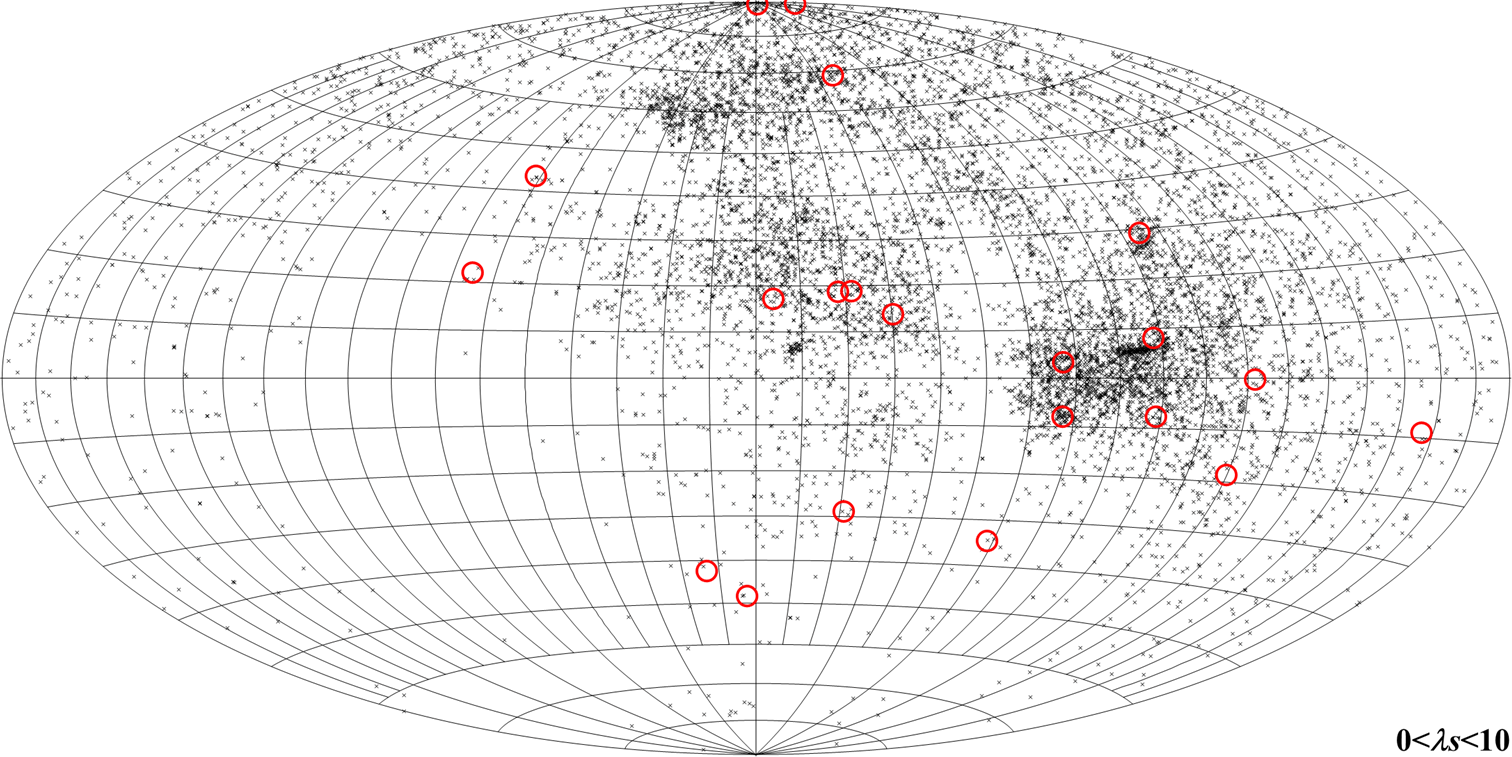
Figure 7 – Radiant distribution obtained by the Global Meteor Network during the interval 0° < λʘ < 10°, the black crosses are the individual GMN radiants, the red circles the radiants according to the IAU shower database.
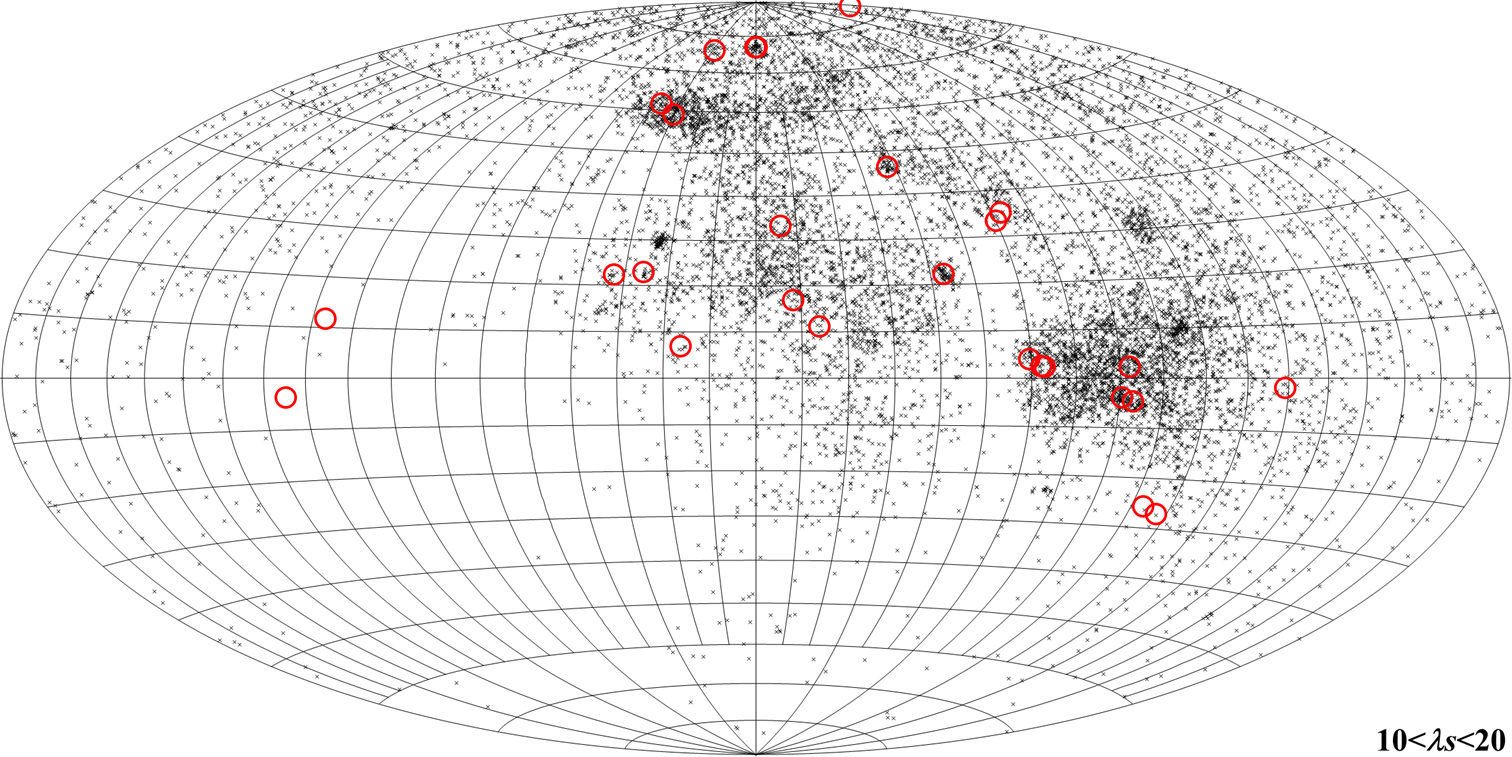
Figure 8 – Radiant distribution obtained by the Global Meteor Network during the interval 10° < λʘ < 20°, the black crosses are the individual GMN radiants, the red circles the radiants according to the IAU shower database.
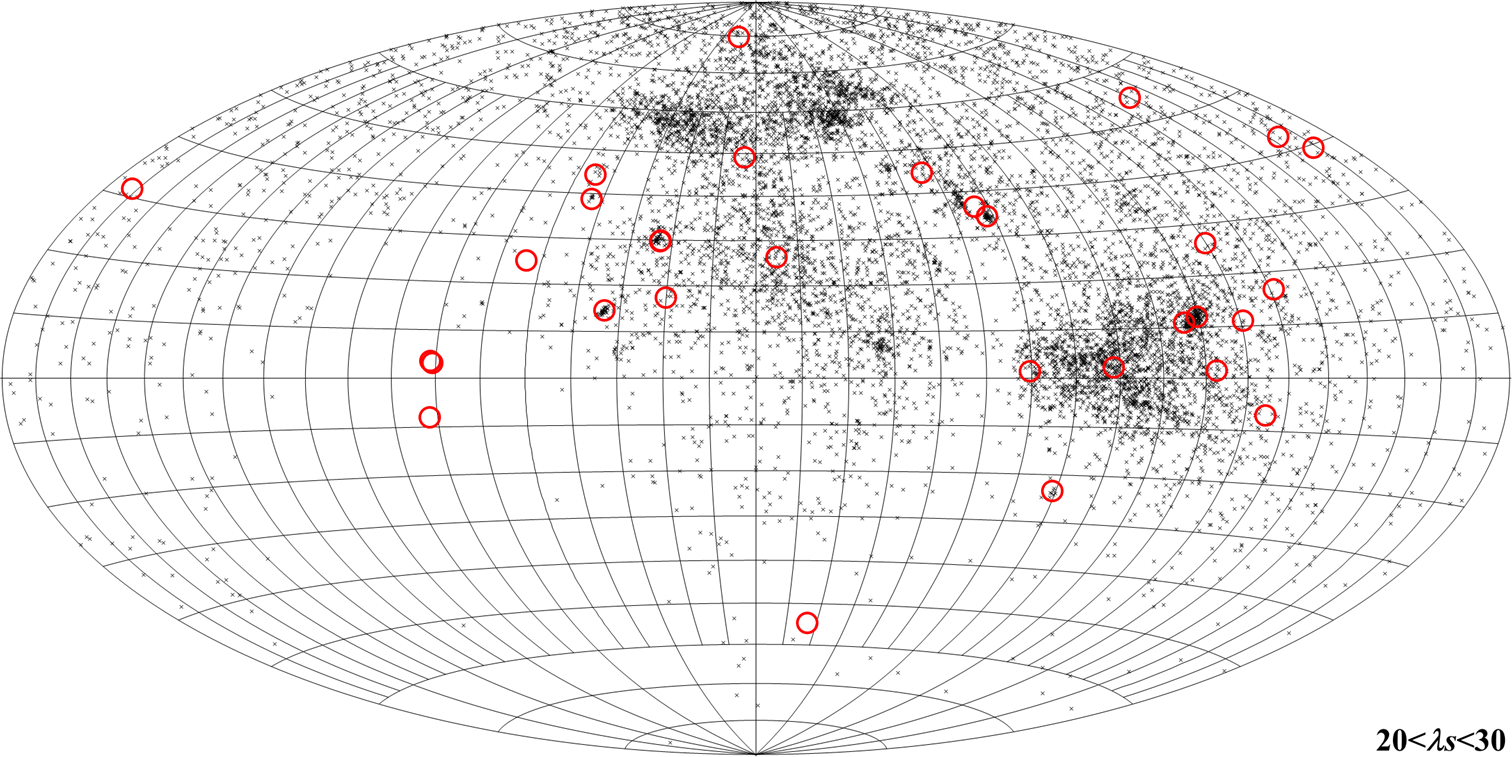
Figure 9 – Radiant distribution obtained by the Global Meteor Network during the interval 20° < λʘ < 30°, the black crosses are the individual GMN radiants, the red circles the radiants according to the IAU shower database.
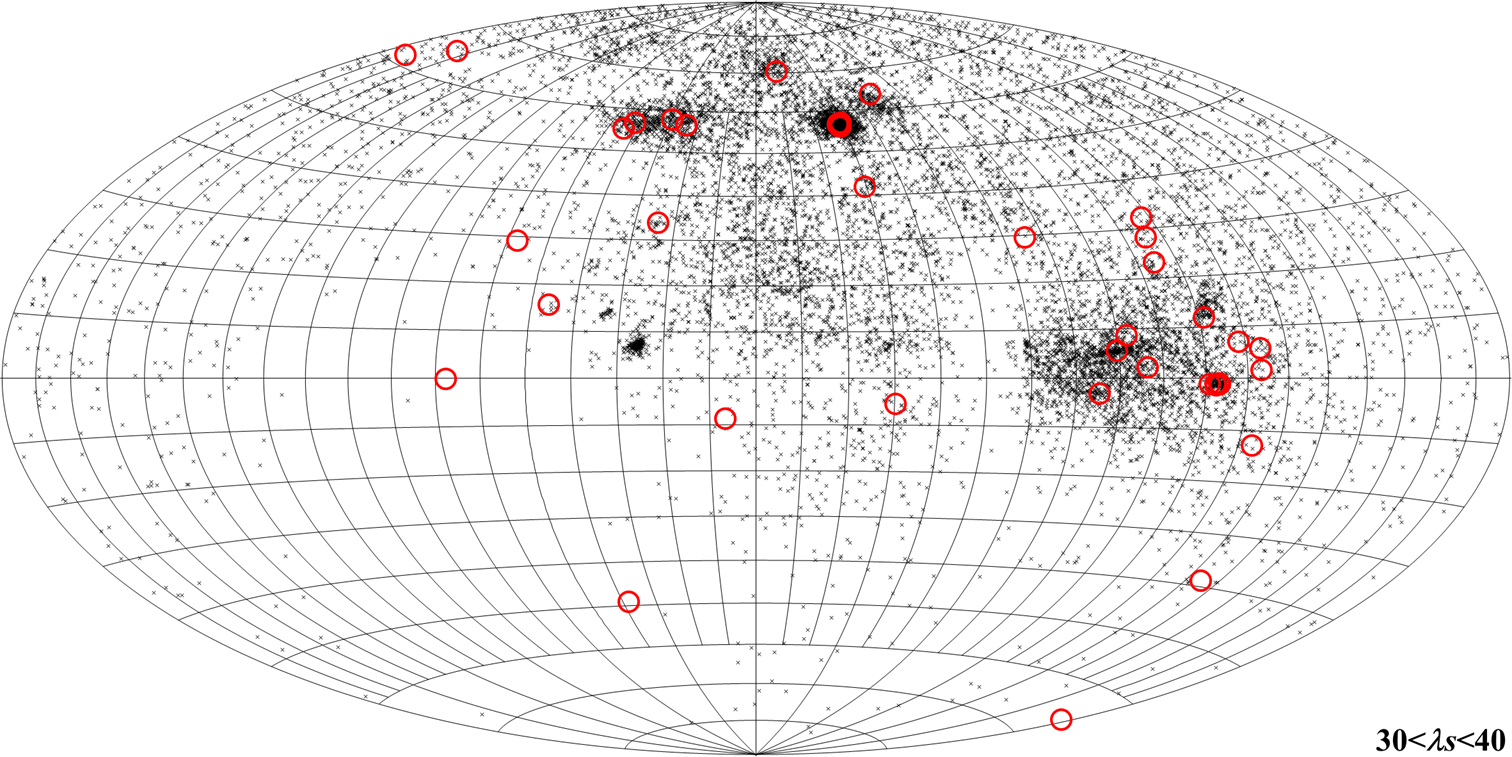
Figure 10 – Radiant distribution obtained by the Global Meteor Network during the interval 30° < λʘ < 40°, the black crosses are the individual GMN radiants, the red circles the radiants according to the IAU shower database.
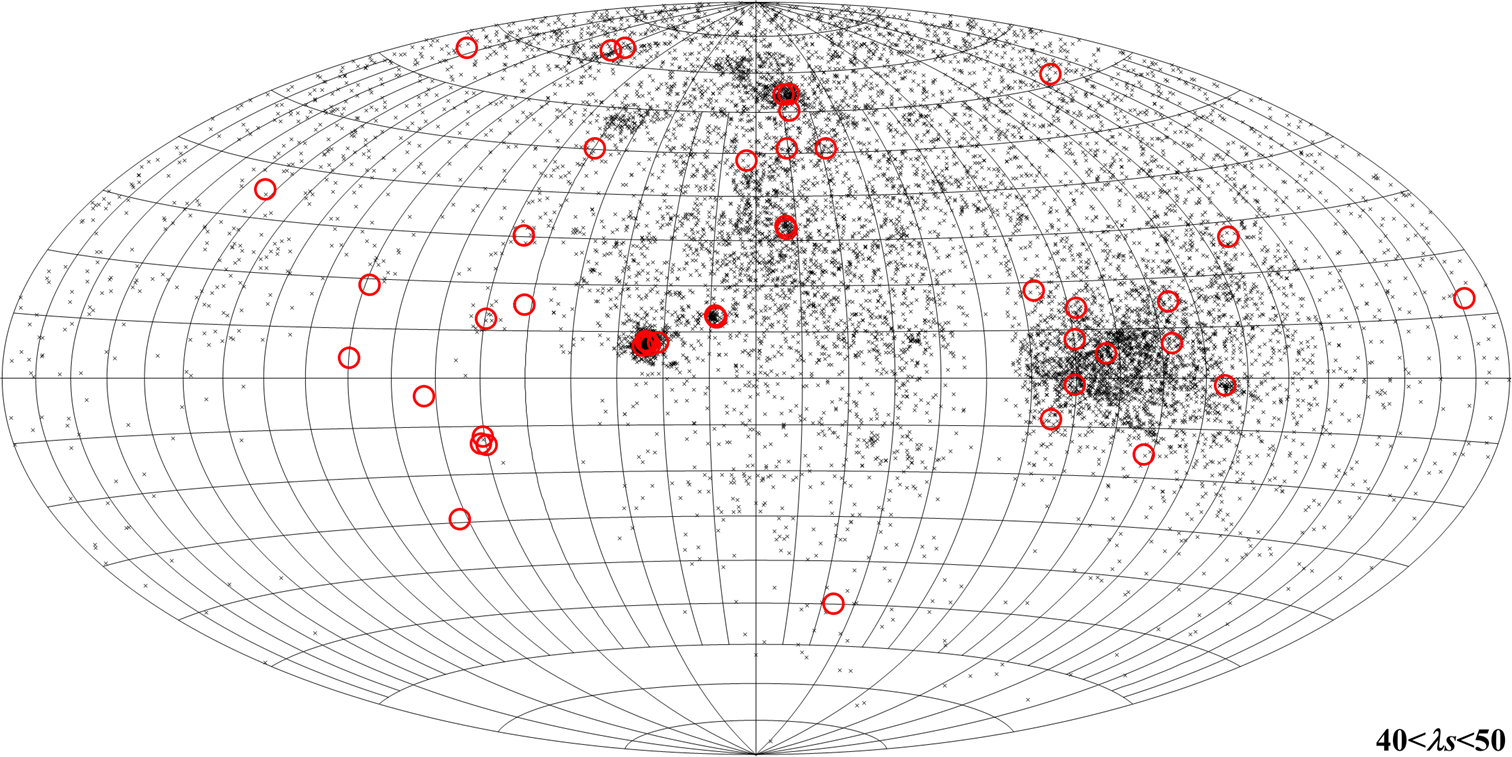
Figure 11 – Radiant distribution obtained by the Global Meteor Network during the interval 40° < λʘ < 50°, the black crosses are the individual GMN radiants, the red circles the radiants according to the IAU shower database.
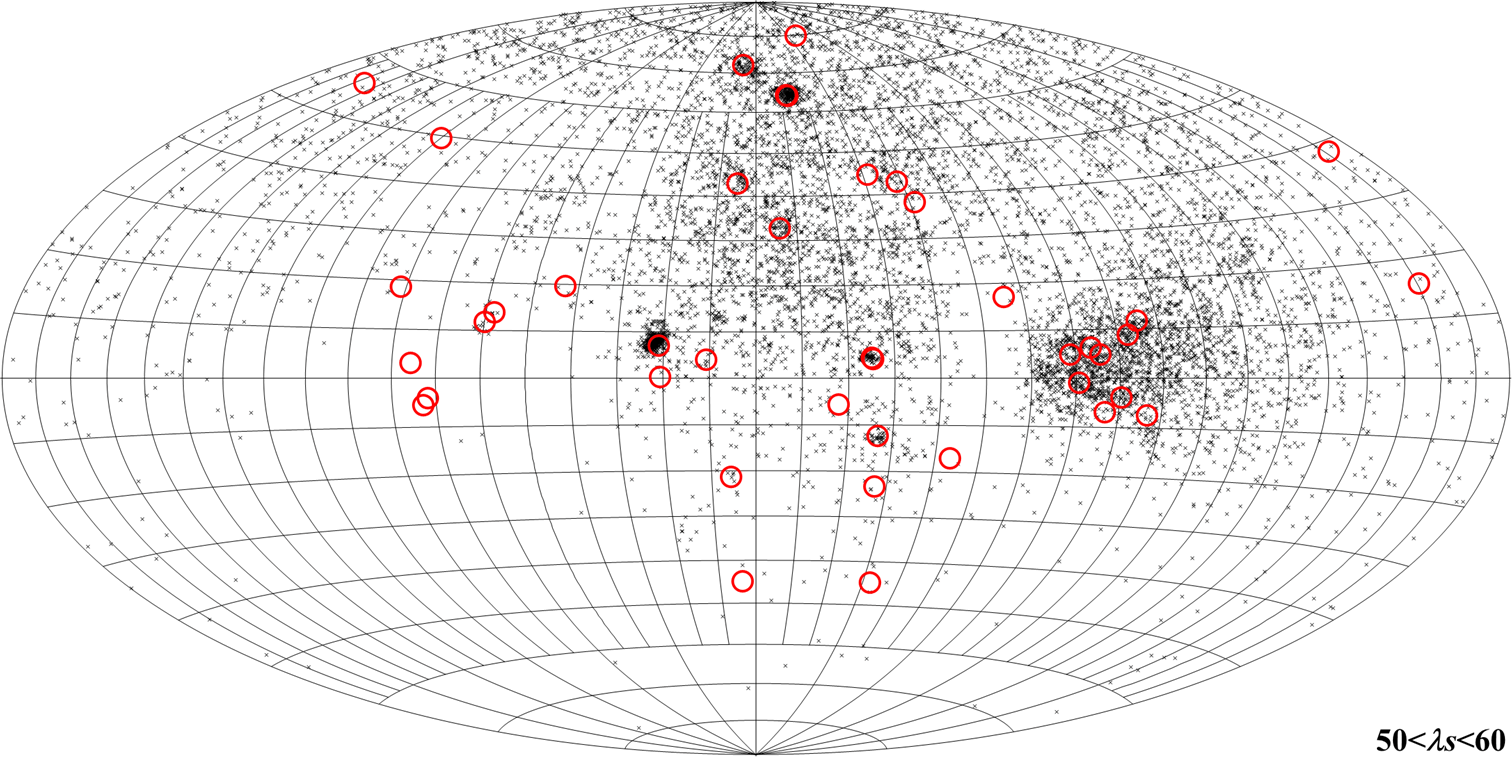
Figure 12 – Radiant distribution obtained by the Global Meteor Network during the interval 50° < λʘ < 60°, the black crosses are the individual GMN radiants, the red circles the radiants according to the IAU shower database.
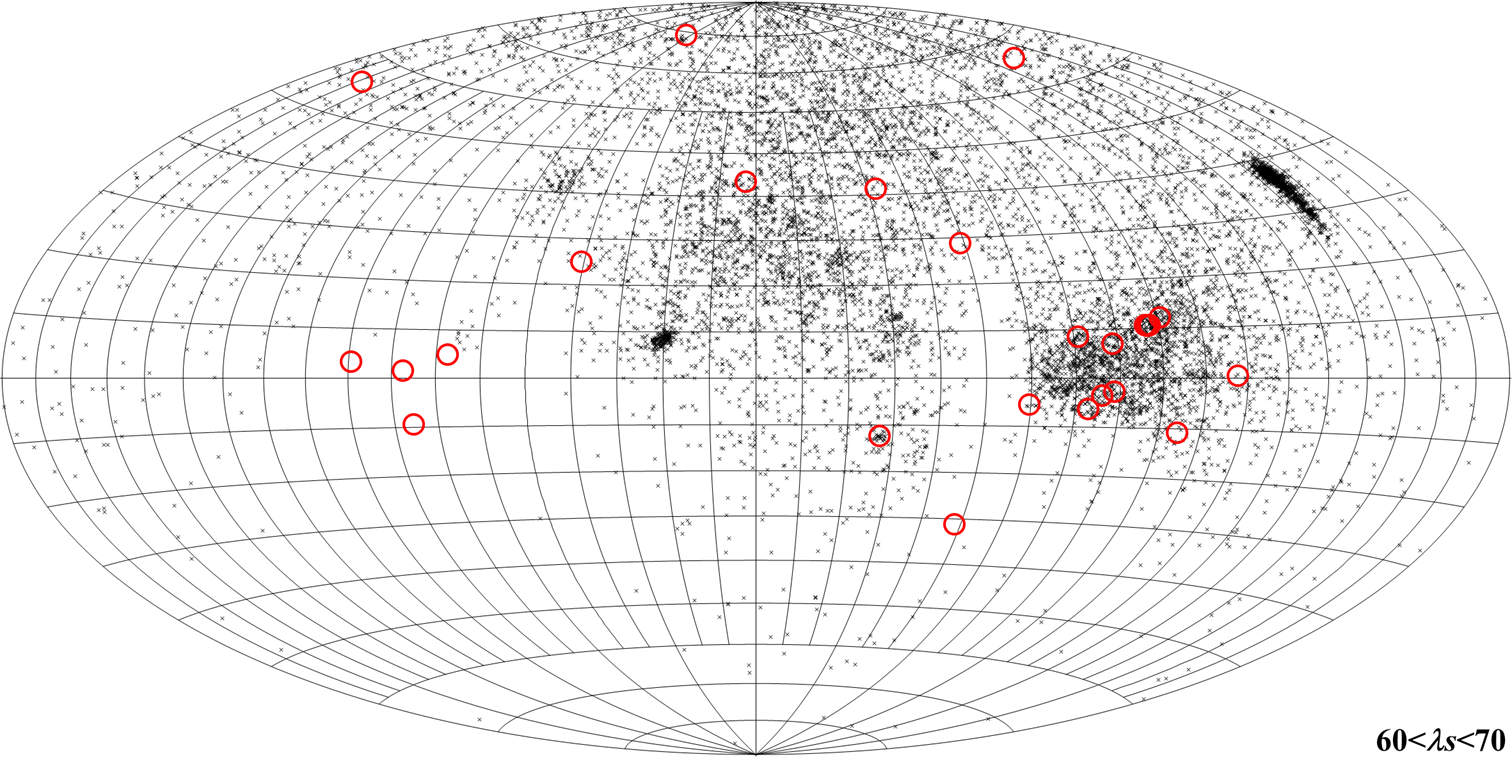
Figure 13 – Radiant distribution obtained by the Global Meteor Network during the interval 60° < λʘ < 70°, the black crosses are the individual GMN radiants, the red circles the radiants according to the IAU shower database.
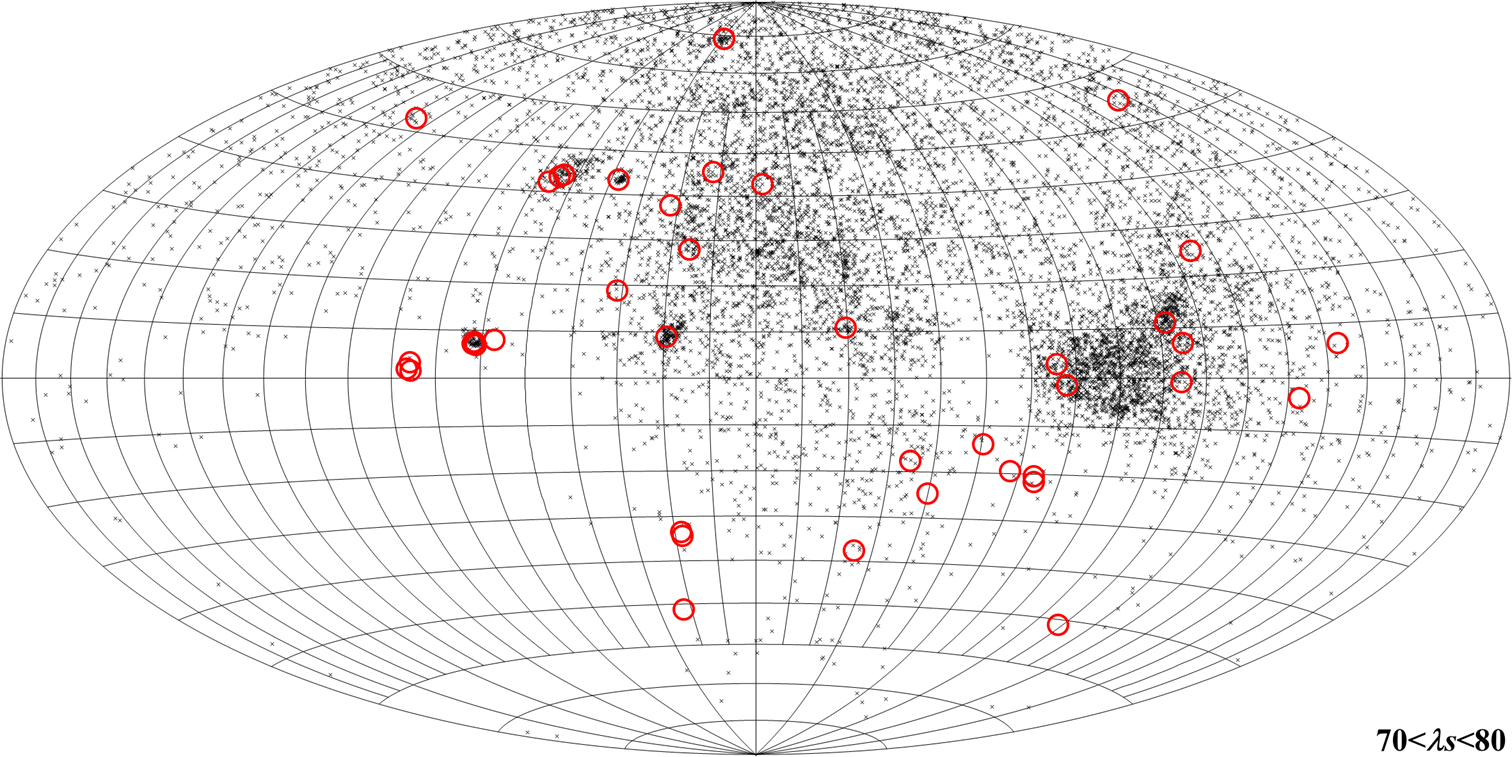
Figure 14 – Radiant distribution obtained by the Global Meteor Network during the interval 70° < λʘ < 80°, the black crosses are the individual GMN radiants, the red circles the radiants according to the IAU shower database.
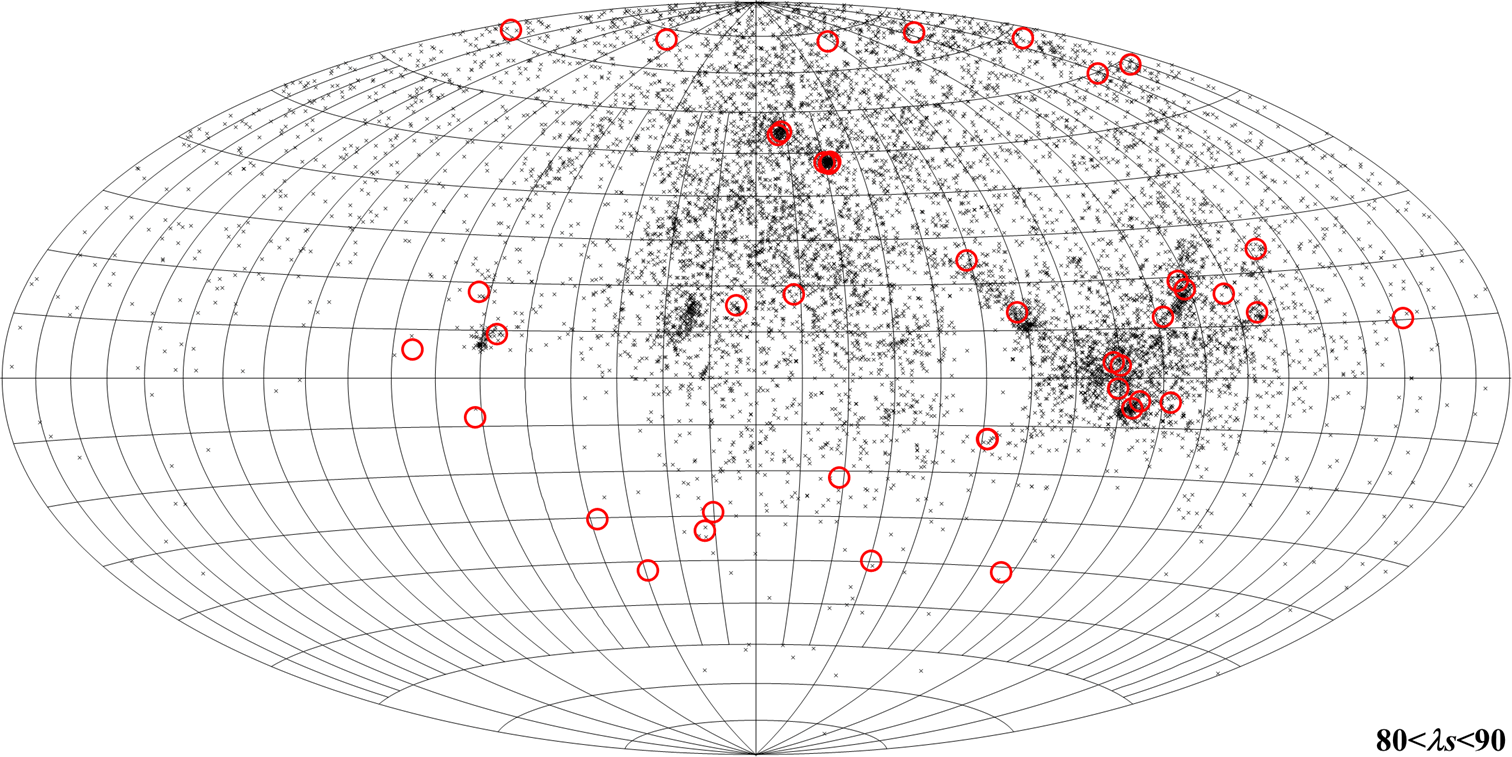
Figure 15 – Radiant distribution obtained by the Global Meteor Network during the interval 80° < λʘ < 90°, the black crosses are the individual GMN radiants, the red circles the radiants according to the IAU shower database.
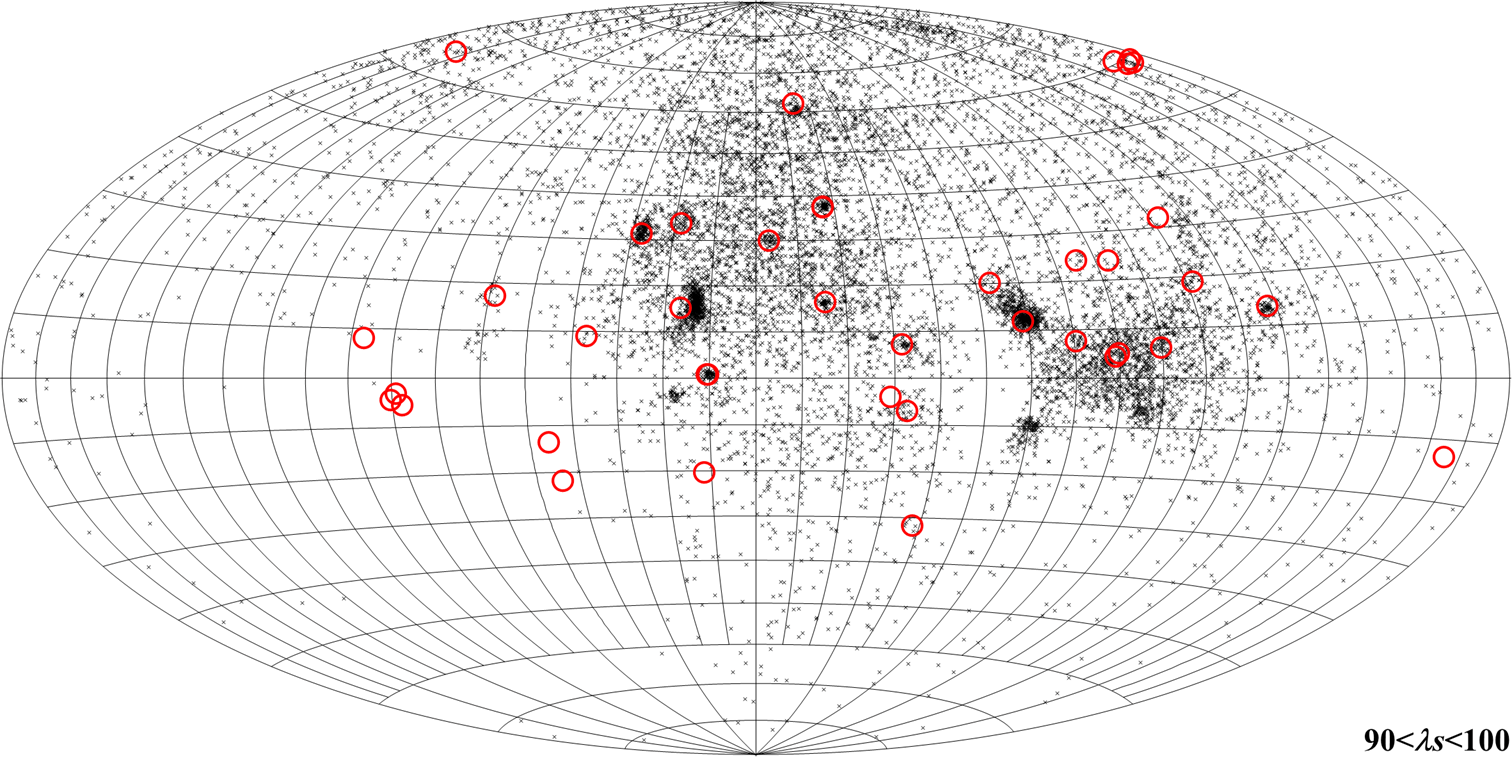
Figure 16 – Radiant distribution obtained by the Global Meteor Network during the interval 90° < λʘ < 100°, the black crosses are the individual GMN radiants, the red circles the radiants according to the IAU shower database.
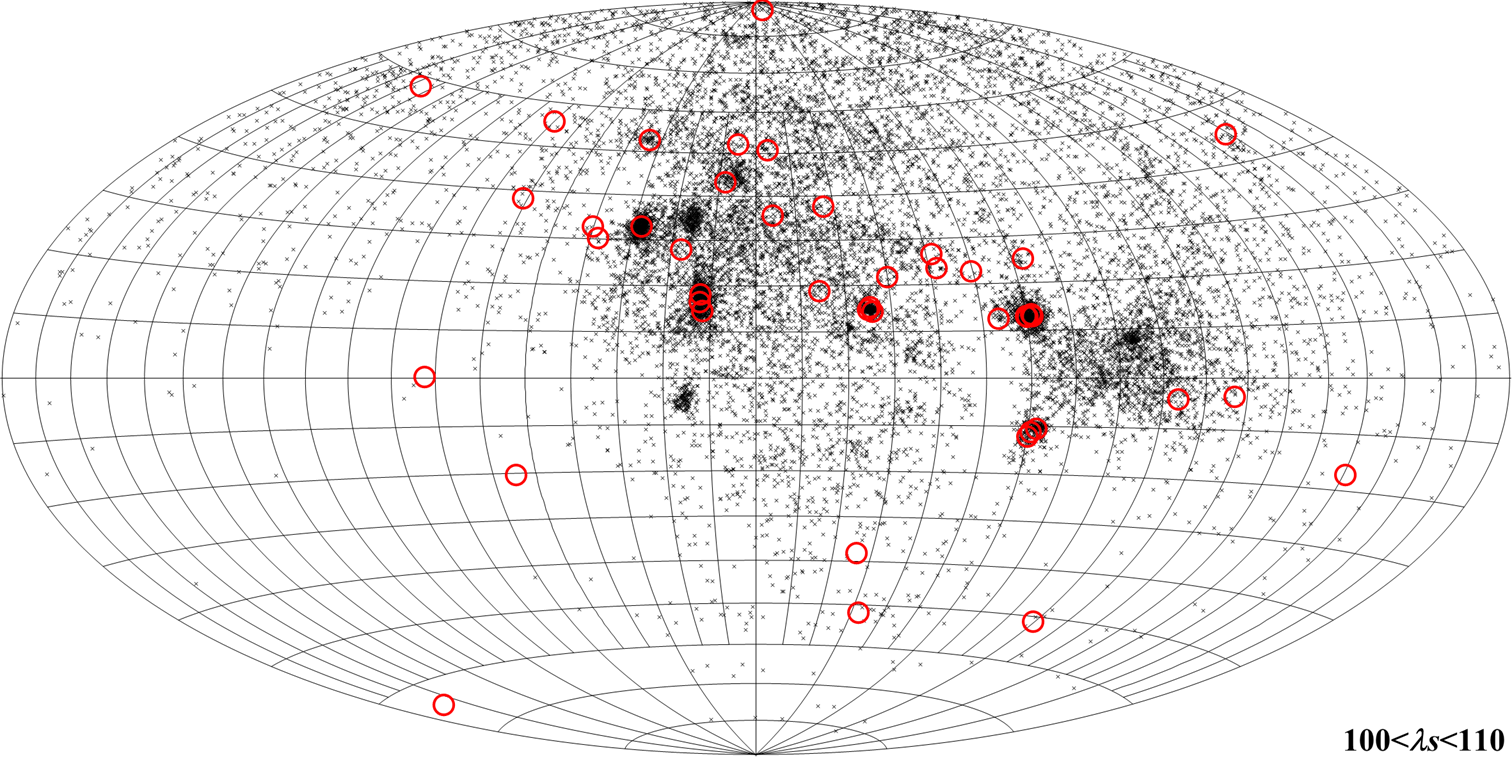
Figure 17 – Radiant distribution obtained by the Global Meteor Network during the interval 100° < λʘ < 110°, the black crosses are the individual GMN radiants, the red circles the radiants according to the IAU shower database.
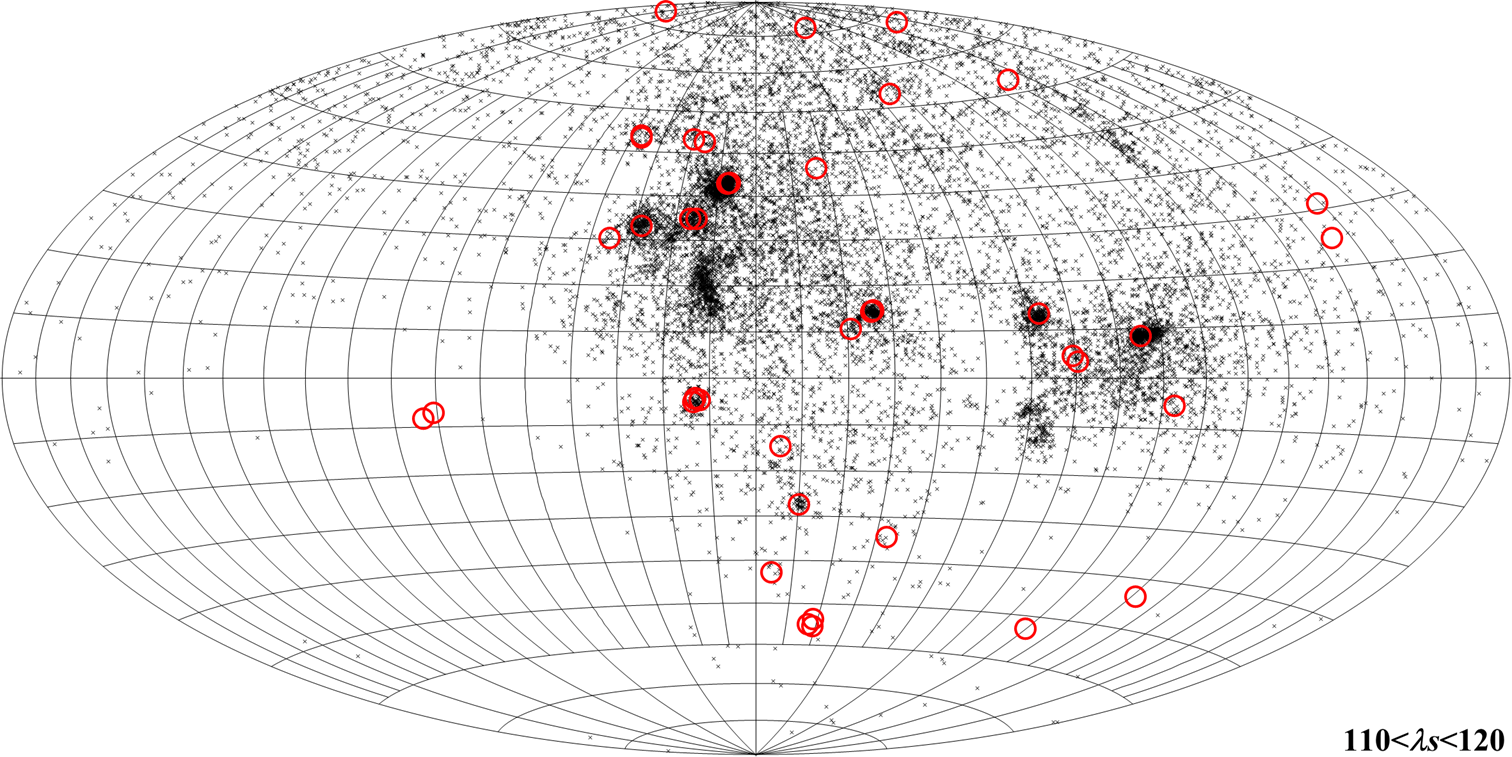
Figure 18 – Radiant distribution obtained by the Global Meteor Network during the interval 110° < λʘ < 120°, the black crosses are the individual GMN radiants, the red circles the radiants according to the IAU shower database.
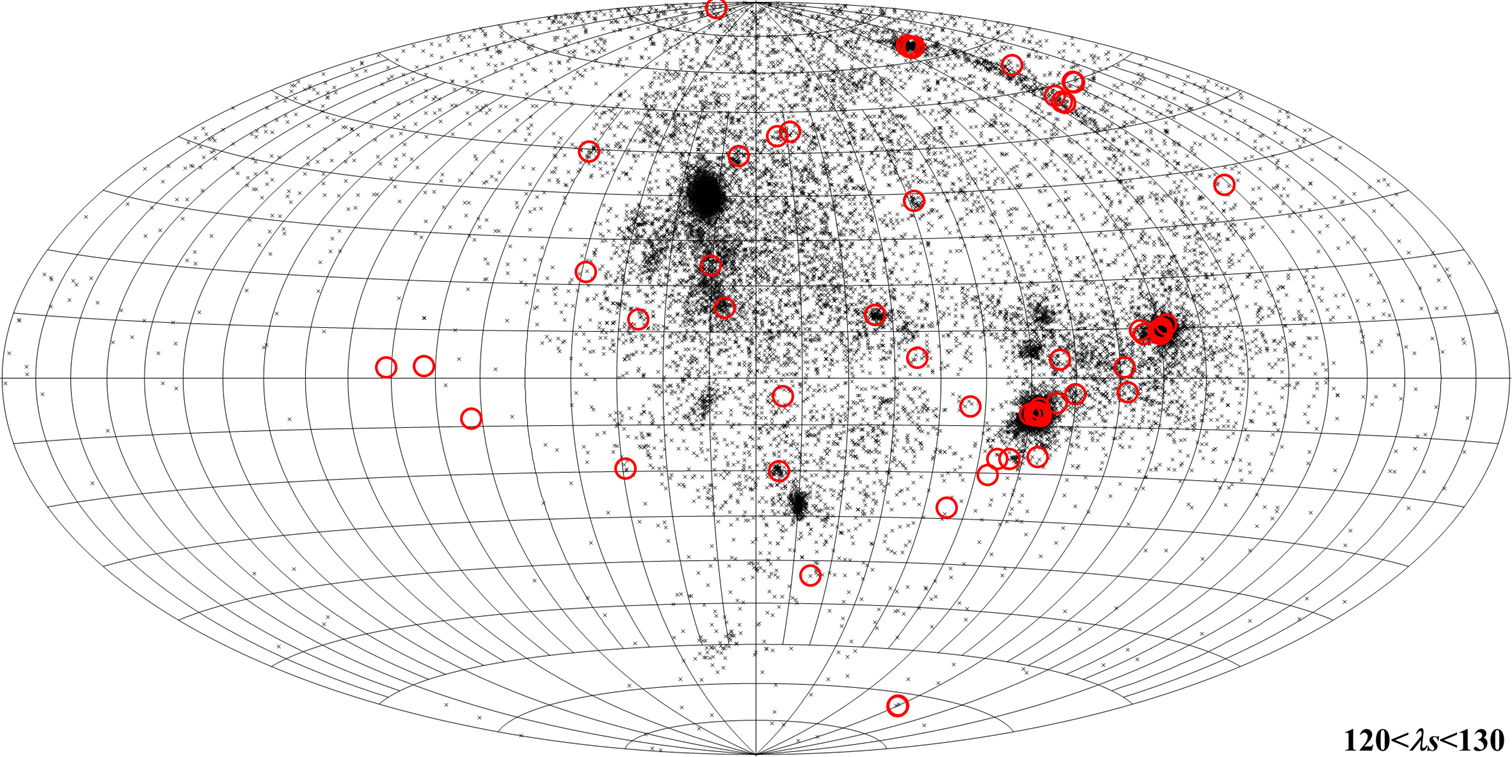
Figure 19 – Radiant distribution obtained by the Global Meteor Network during the interval 120° < λʘ < 130°, the black crosses are the individual GMN radiants, the red circles the radiants according to the IAU shower database.
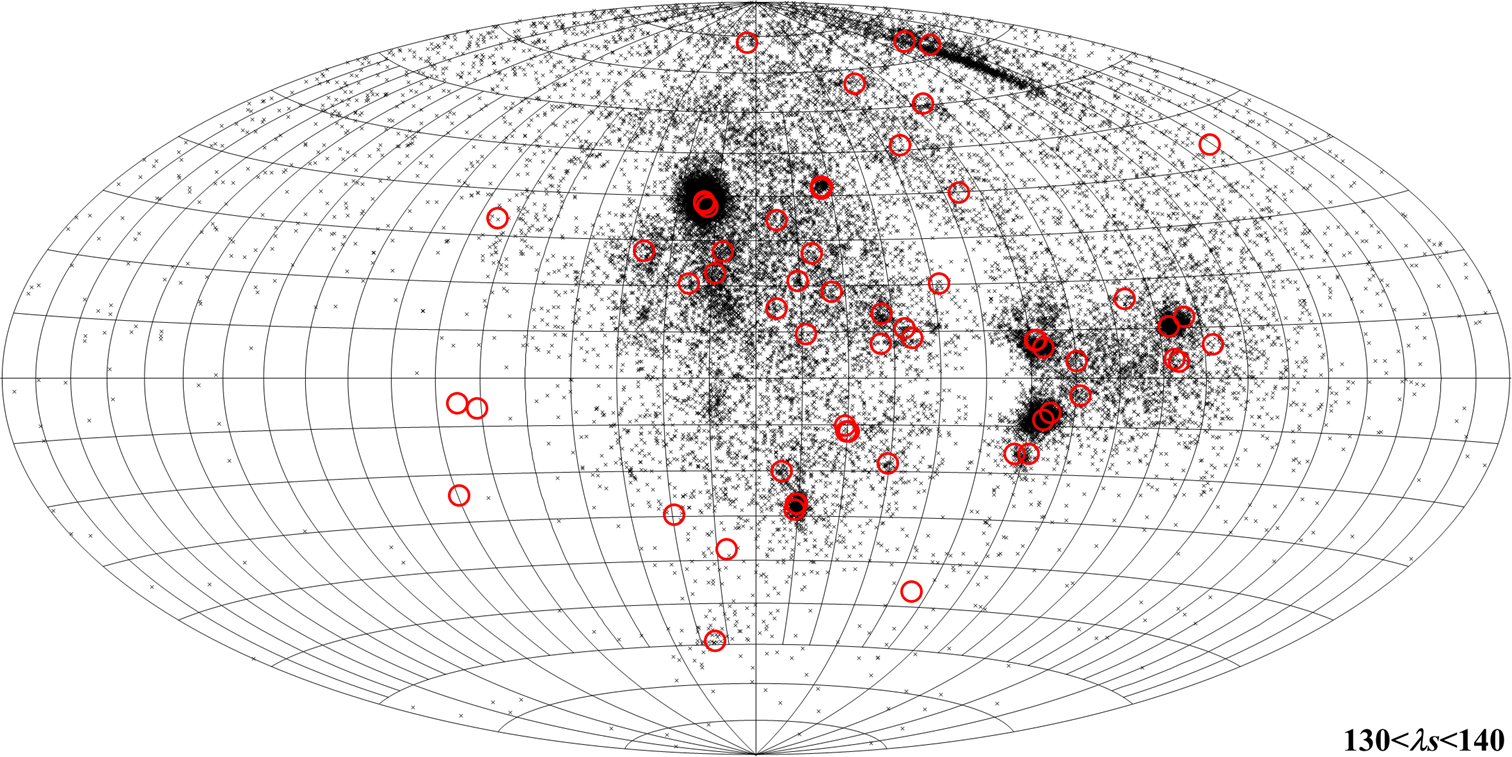
Figure 20 – Radiant distribution obtained by the Global Meteor Network during the interval 130° < λʘ < 140°, the black crosses are the individual GMN radiants, the red circles the radiants according to the IAU shower database.
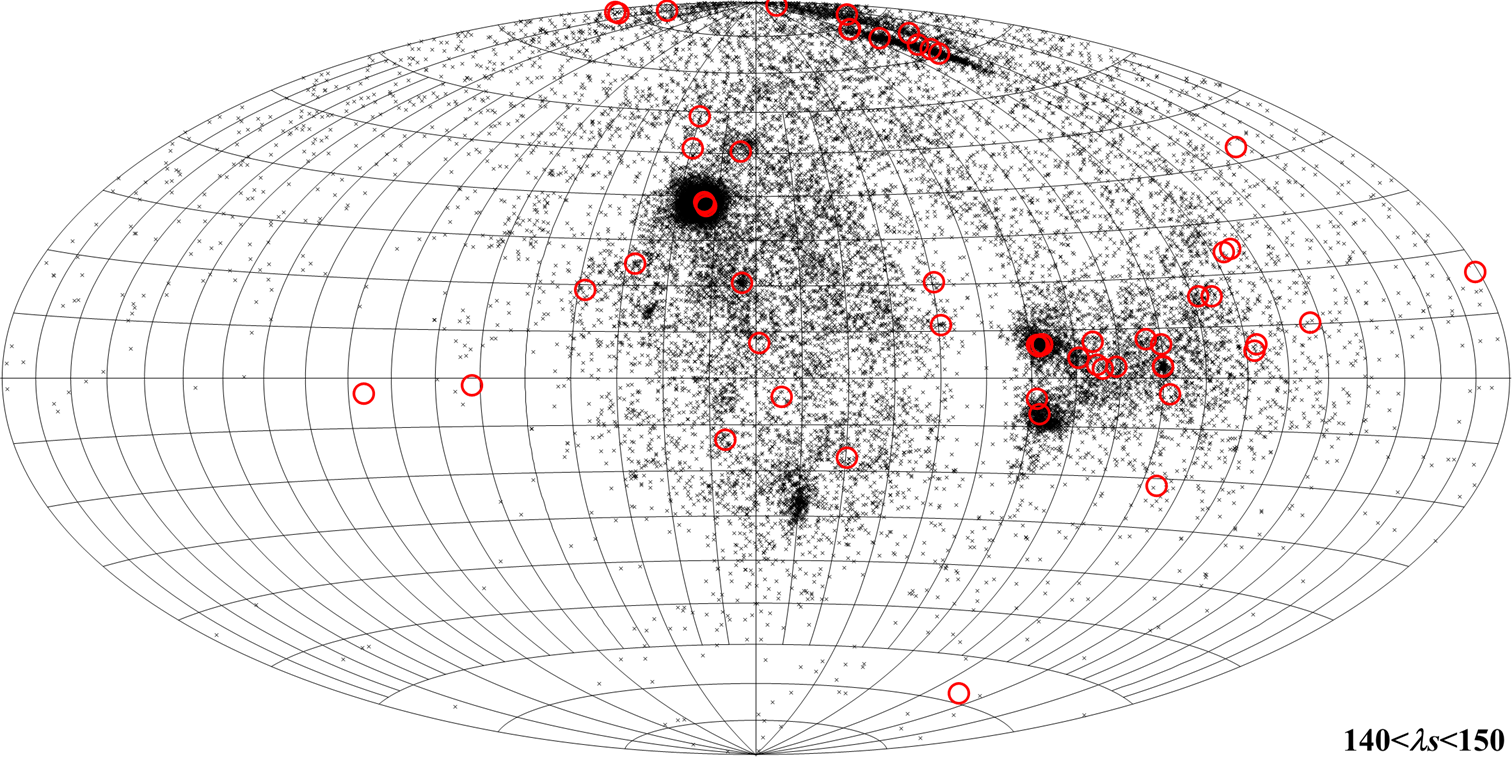
Figure 21 – Radiant distribution obtained by the Global Meteor Network during the interval 140° < λʘ < 150°, the black crosses are the individual GMN radiants, the red circles the radiants according to the IAU shower database.
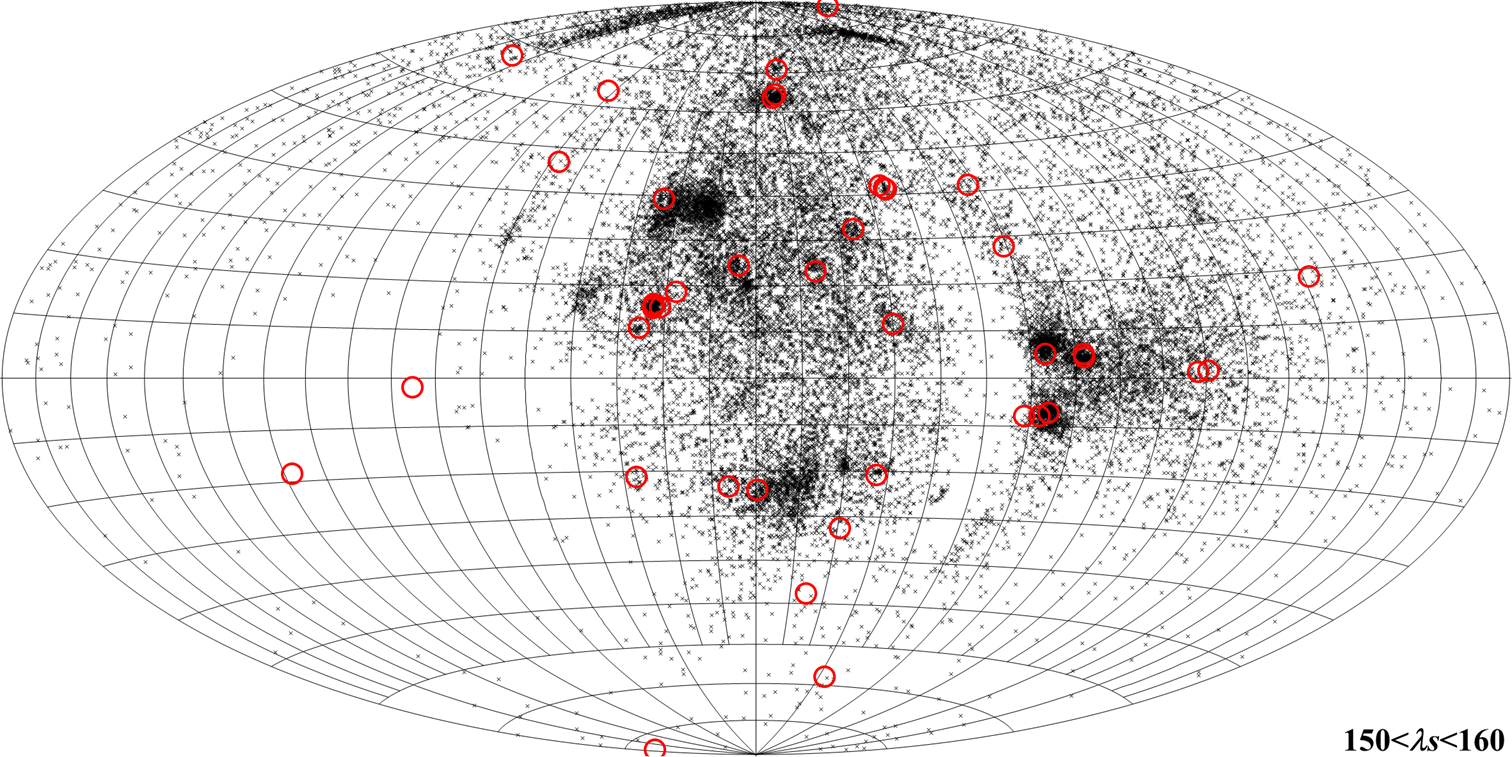
Figure 22 – Radiant distribution obtained by the Global Meteor Network during the interval 150° < λʘ < 160°, the black crosses are the individual GMN radiants, the red circles the radiants according to the IAU shower database.
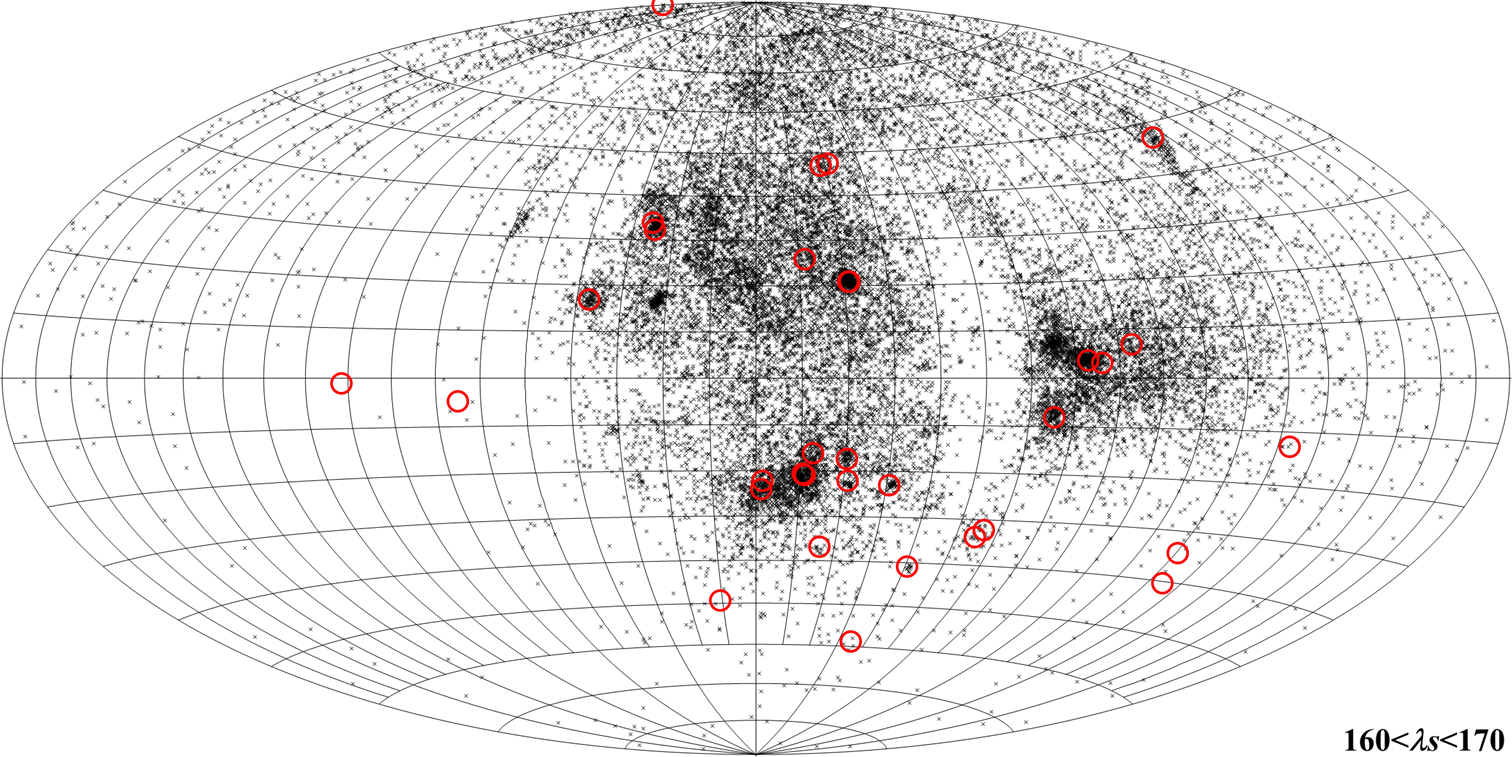
Figure 23 – Radiant distribution obtained by the Global Meteor Network during the interval 160° < λʘ < 170°, the black crosses are the individual GMN radiants, the red circles the radiants according to the IAU shower database.
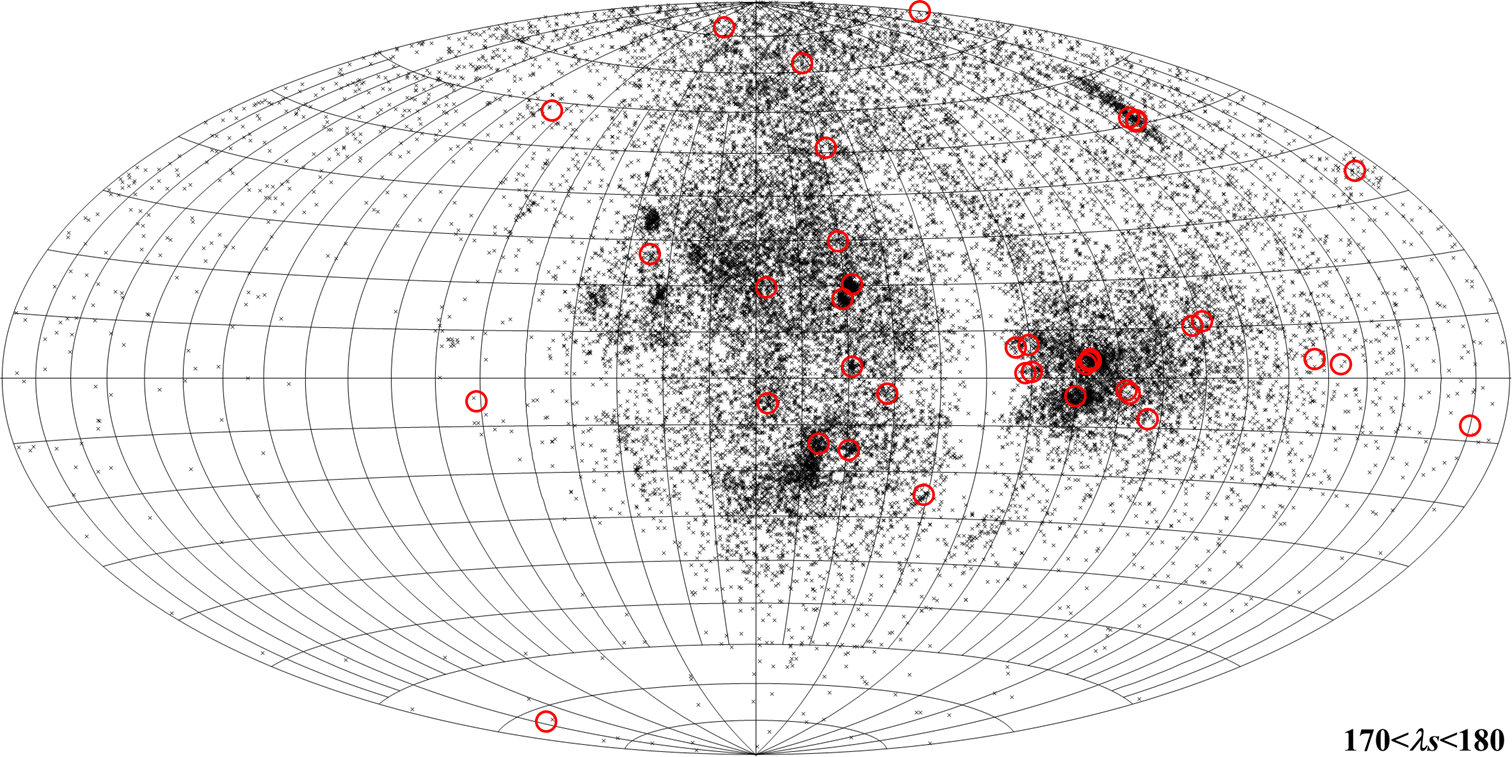
Figure 24 – Radiant distribution obtained by the Global Meteor Network during the interval 170° < λʘ < 180°, the black crosses are the individual GMN radiants, the red circles the radiants according to the IAU shower database.
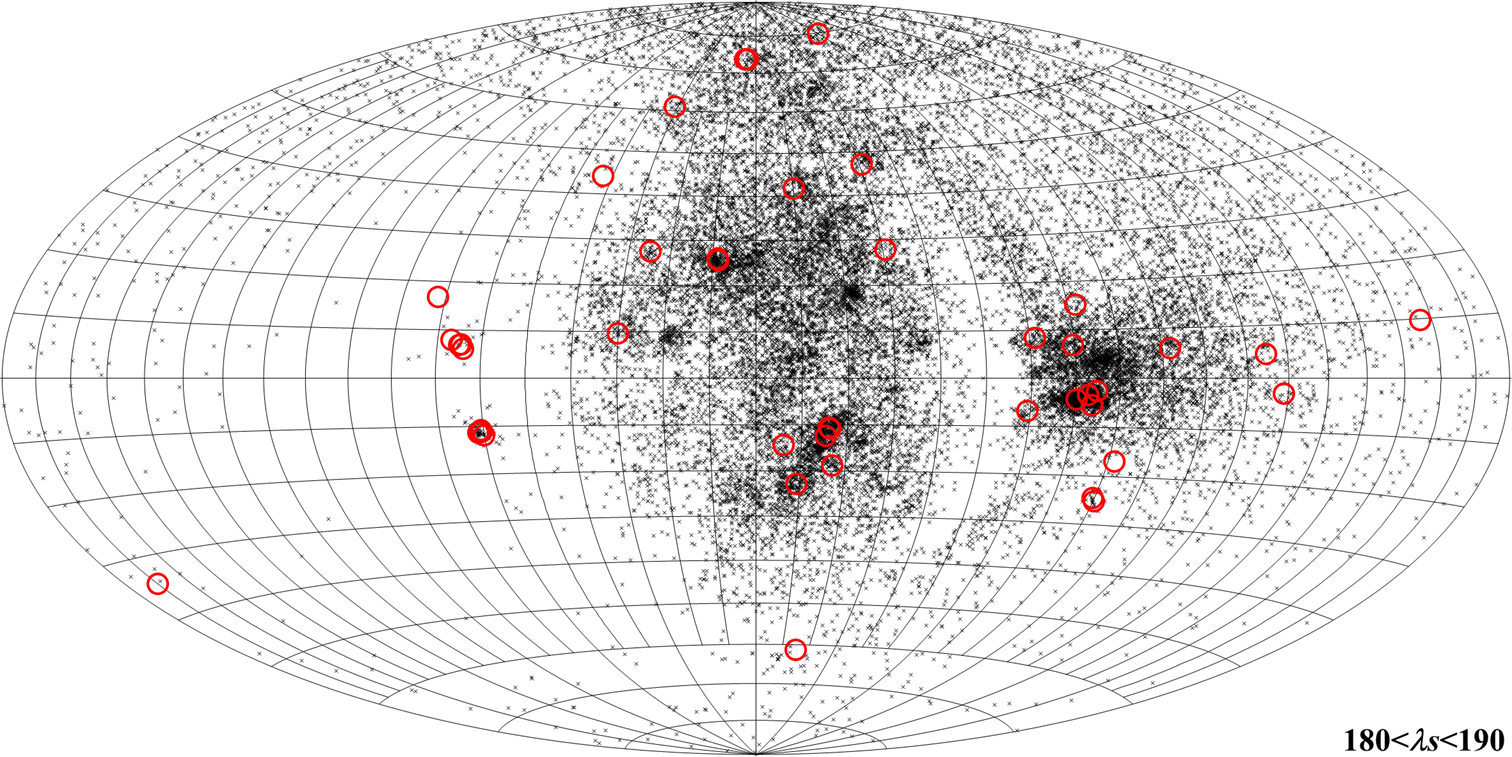
Figure 25 – Radiant distribution obtained by the Global Meteor Network during the interval 180° < λʘ < 190°, the black crosses are the individual GMN radiants, the red circles the radiants according to the IAU shower database.
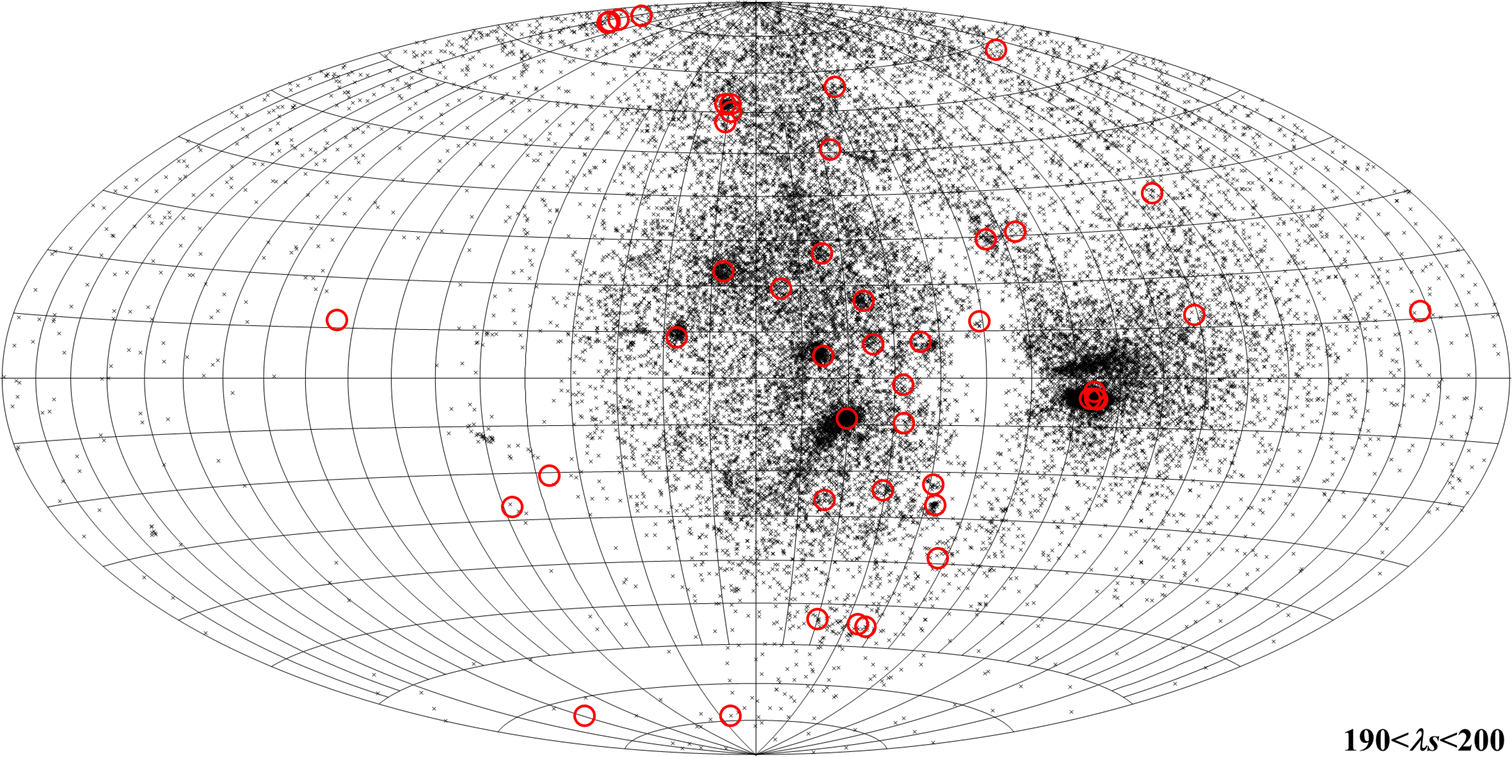
Figure 26 – Radiant distribution obtained by the Global Meteor Network during the interval 190° < λʘ < 200°, the black crosses are the individual GMN radiants, the red circles the radiants according to the IAU shower database.
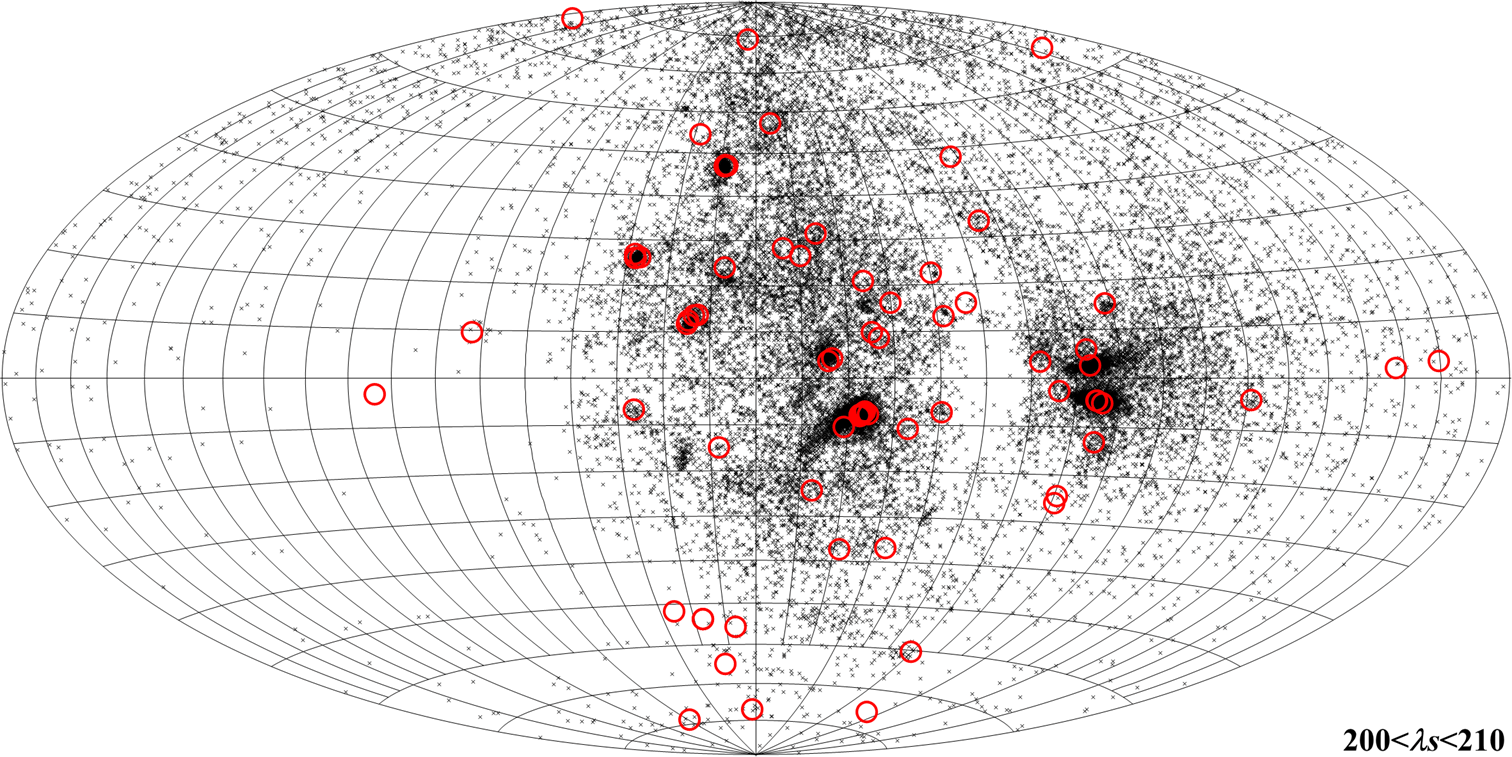
Figure 27 – Radiant distribution obtained by the Global Meteor Network during the interval 200° < λʘ < 210°, the black crosses are the individual GMN radiants, the red circles the radiants according to the IAU shower database .
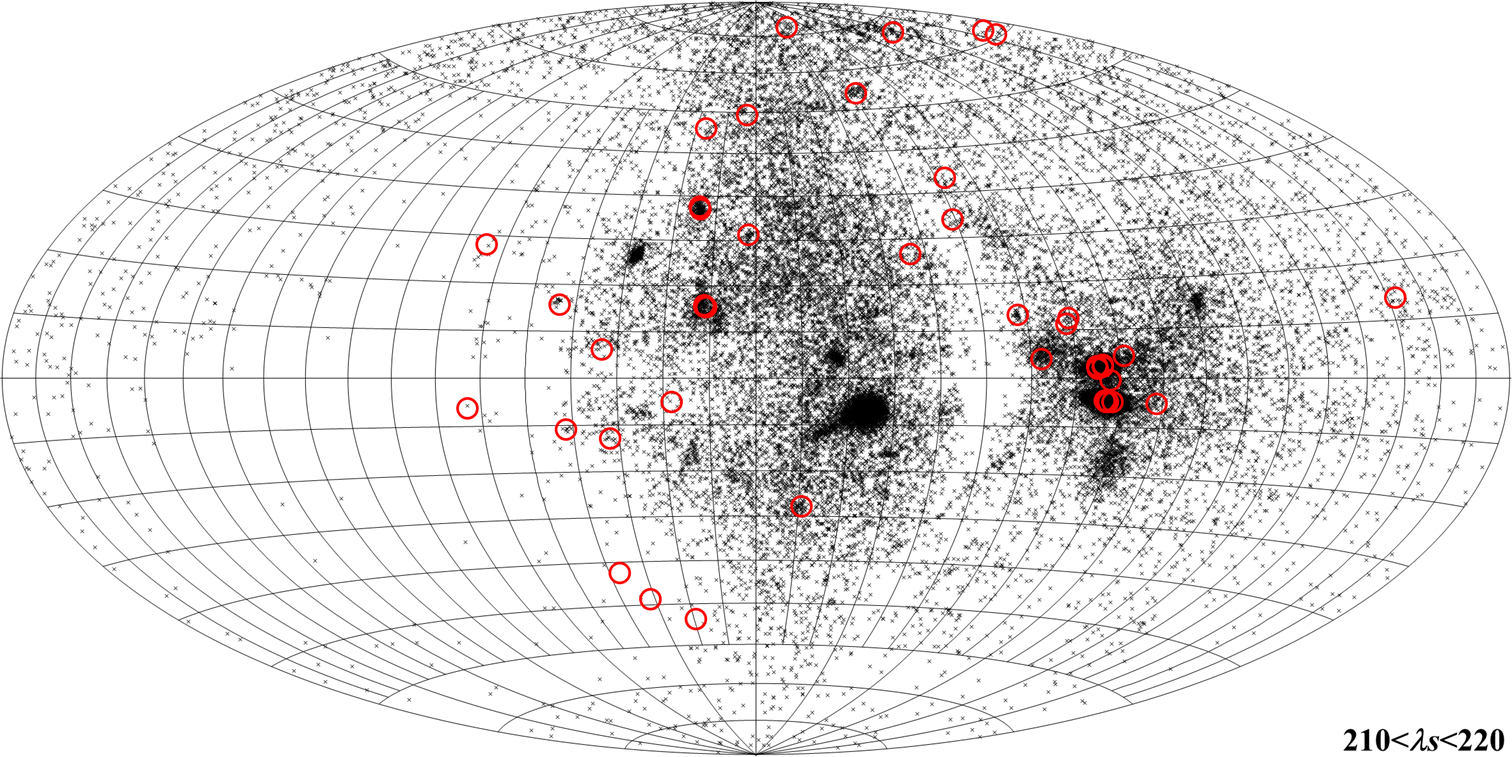
Figure 28 – Radiant distribution obtained by the Global Meteor Network during the interval 210° < λʘ < 220°, the black crosses are the individual GMN radiants, the red circles the radiants according to the IAU shower database.
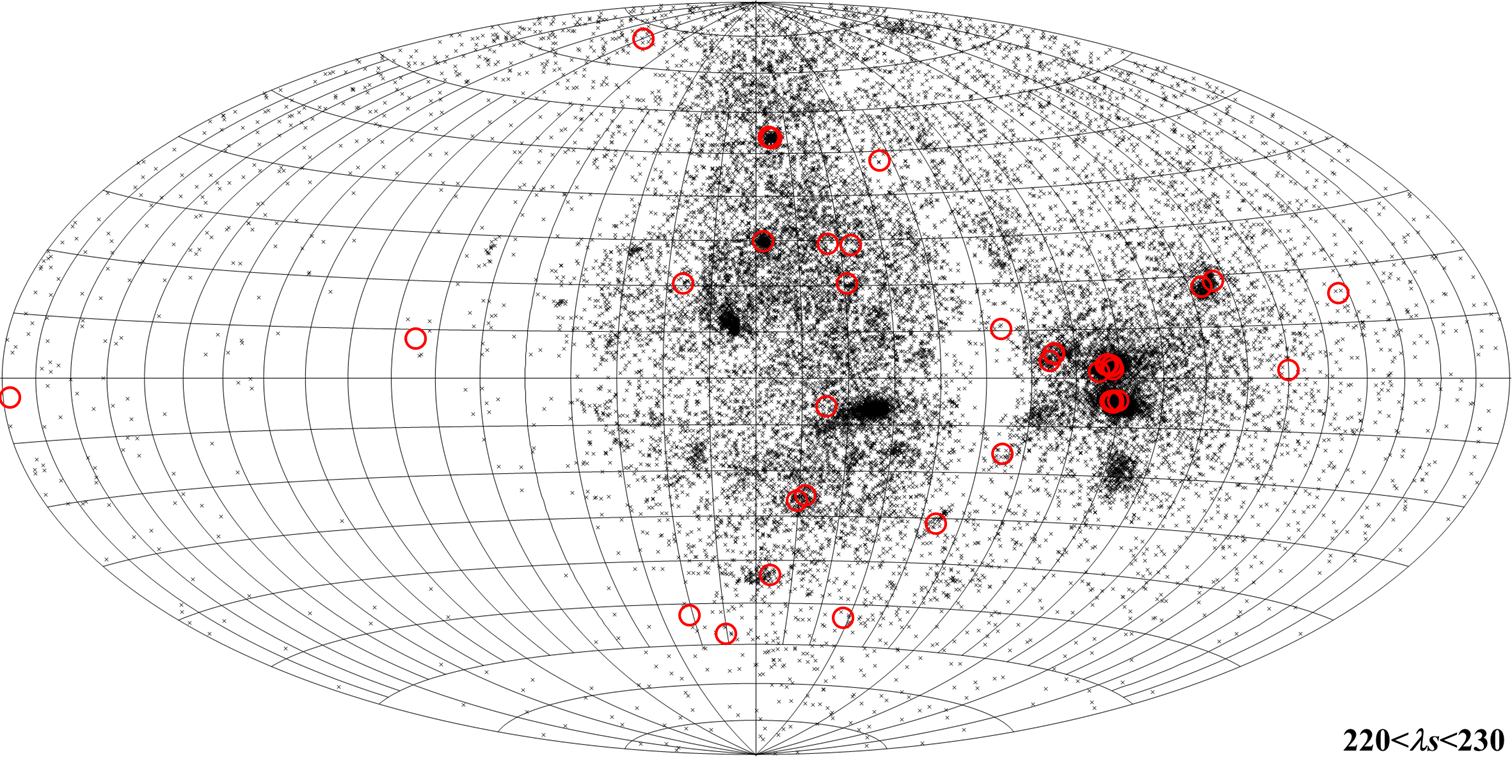
Figure 29 – Radiant distribution obtained by the Global Meteor Network during the interval 220° < λʘ < 230°, the black crosses are the individual GMN radiants, the red circles the radiants according to the IAU shower database.
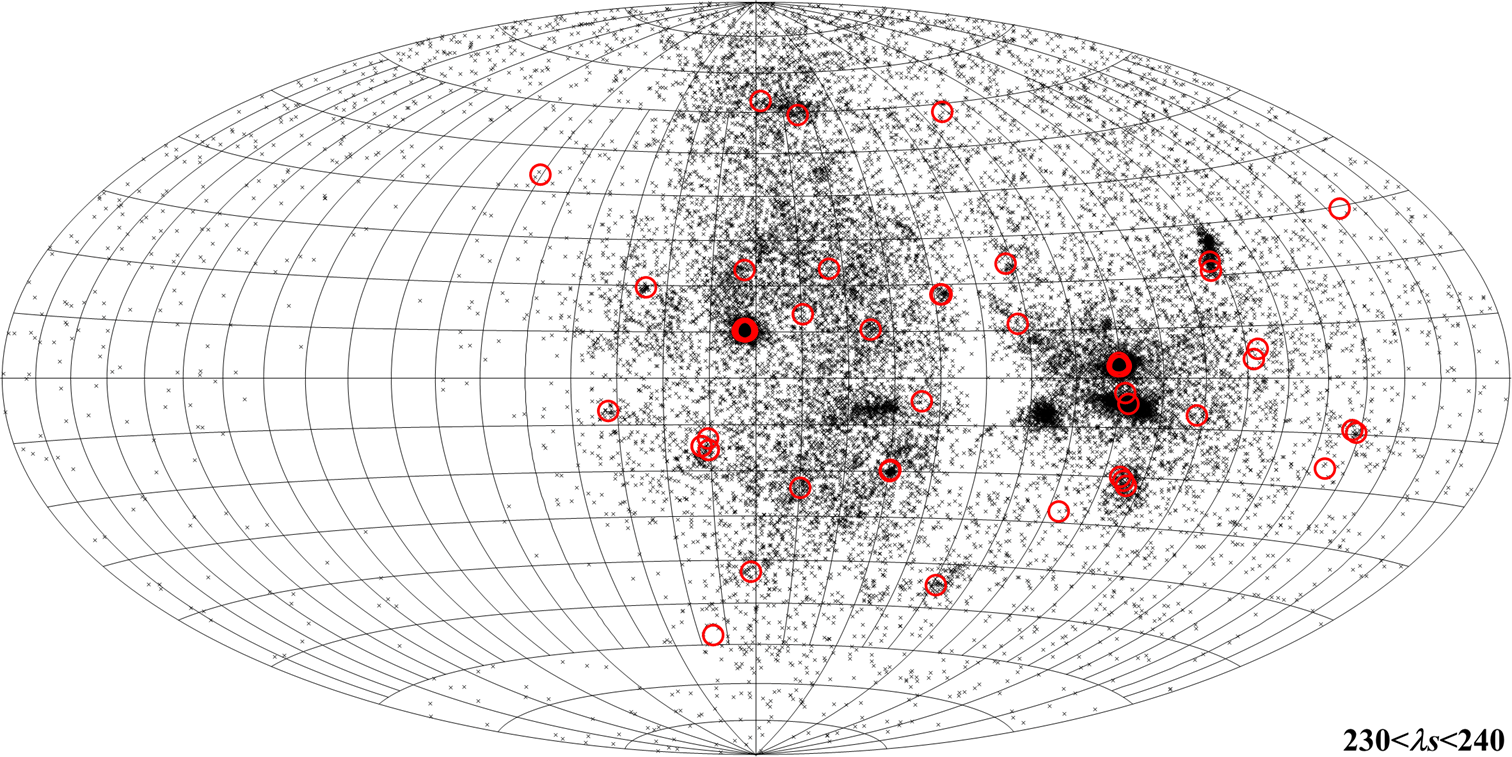
Figure 30 – Radiant distribution obtained by the Global Meteor Network during the interval 230° < λʘ < 240°, the black crosses are the individual GMN radiants, the red circles the radiants according to the IAU shower database.
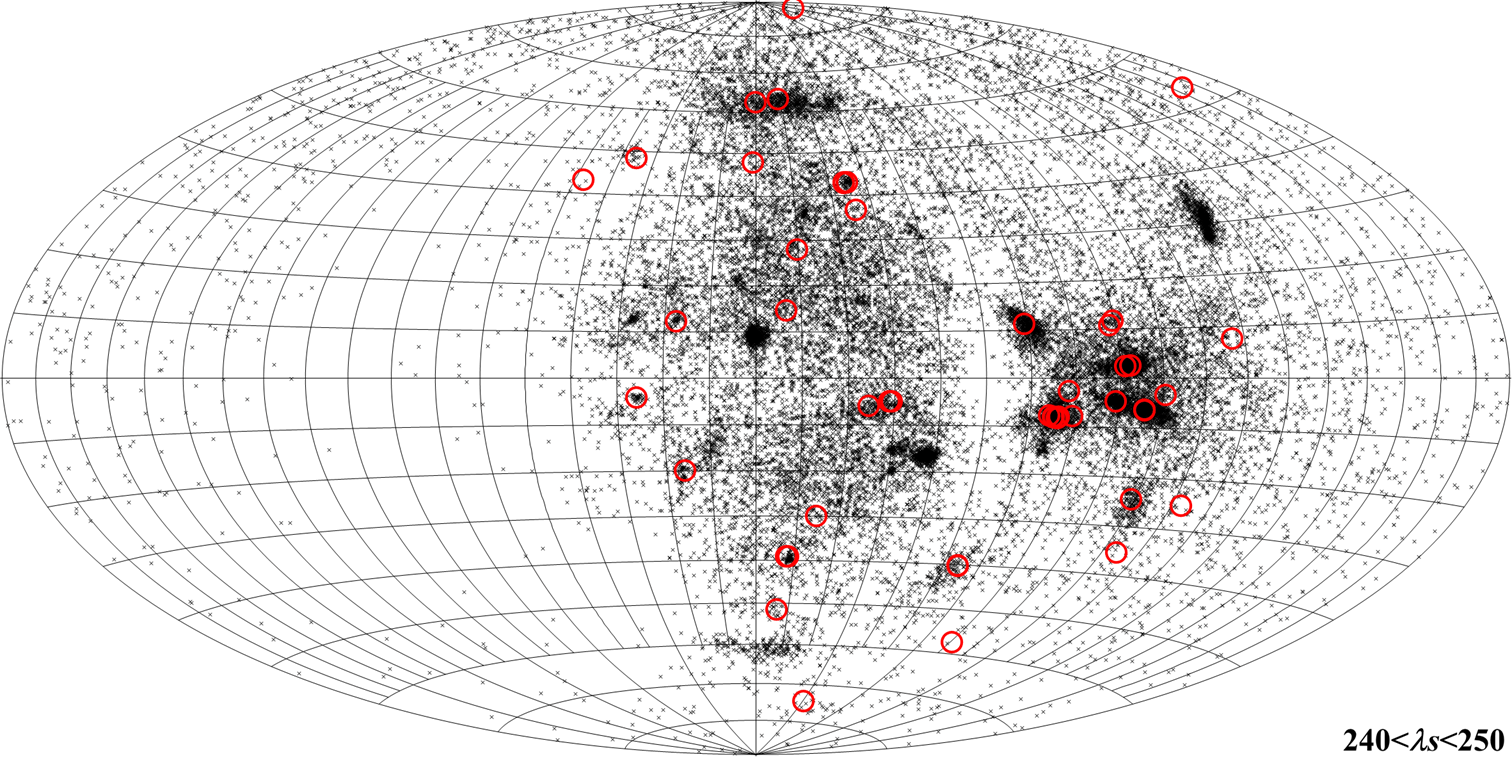
Figure 31 – Radiant distribution obtained by the Global Meteor Network during the interval 240° < λʘ < 250°, the black crosses are the individual GMN radiants, the red circles the radiants according to the IAU shower database.
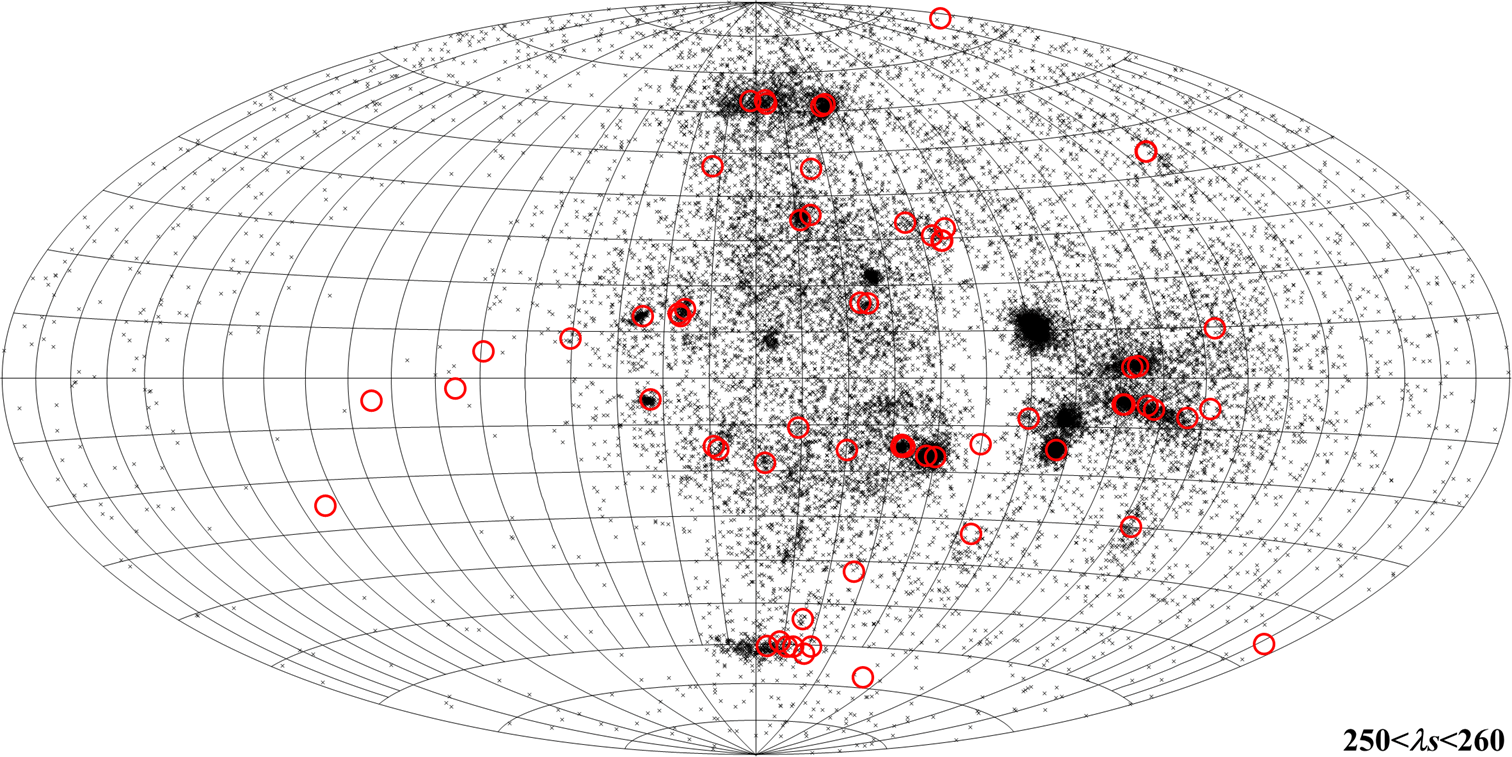
Figure 32 – Radiant distribution obtained by the Global Meteor Network during the interval 250° < λʘ < 260°, the black crosses are the individual GMN radiants, the red circles the radiants according to the IAU shower database.
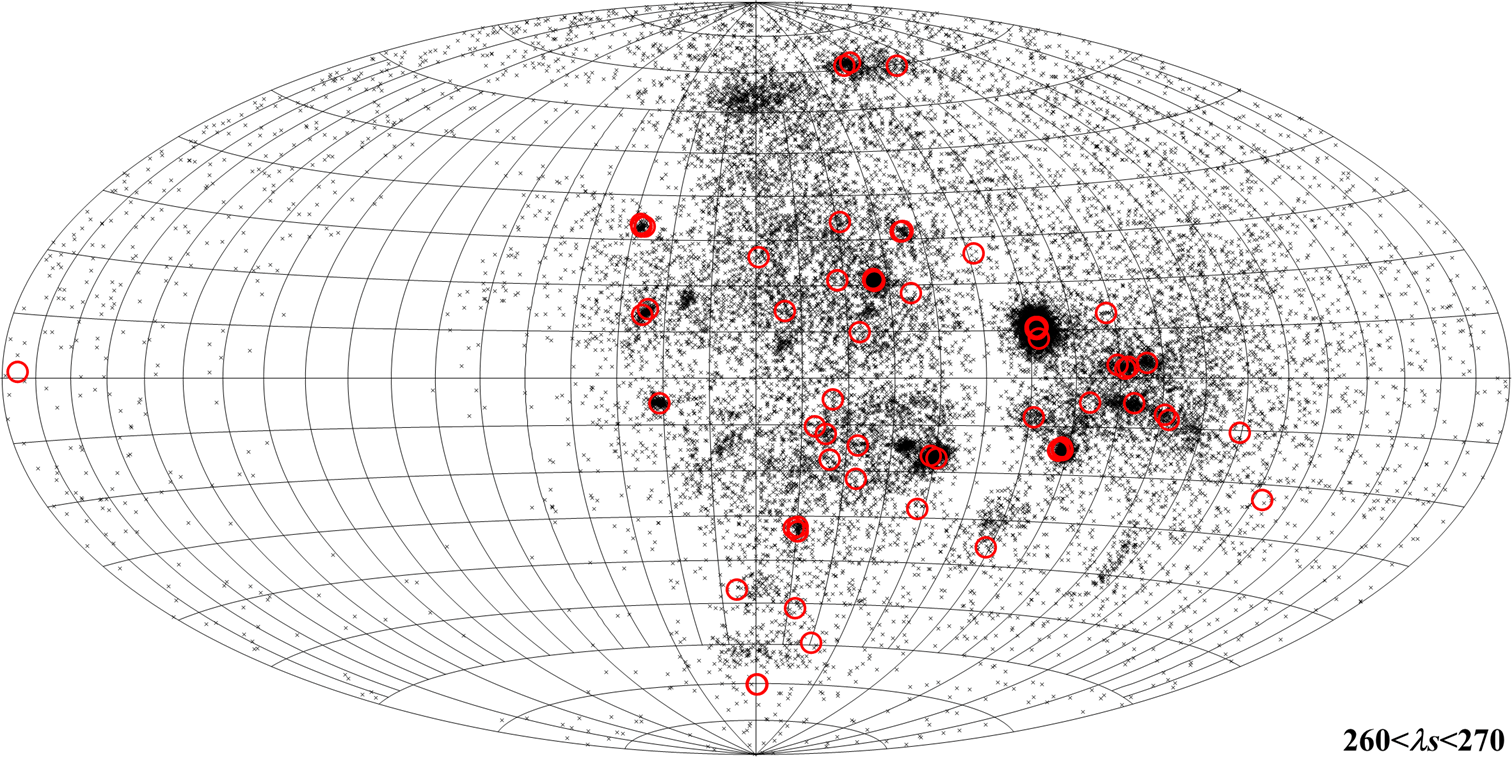
Figure 33 – Radiant distribution obtained by the Global Meteor Network during the interval 260° < λʘ < 270°, the black crosses are the individual GMN radiants, the red circles the radiants according to the IAU shower database.
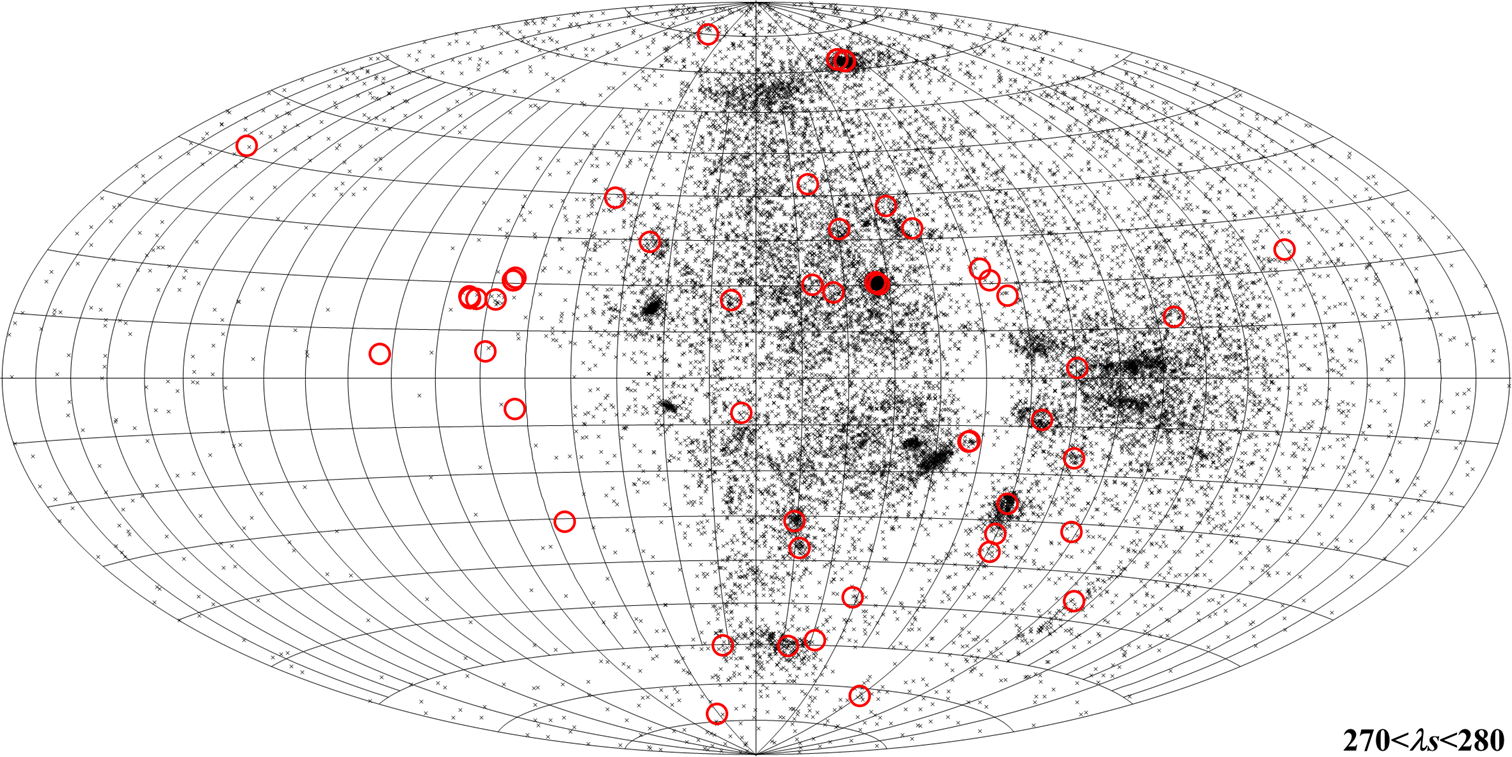
Figure 34 – Radiant distribution obtained by the Global Meteor Network during the interval 270° < λʘ < 280°, the black crosses are the individual GMN radiants, the red circles the radiants according to the IAU shower database.
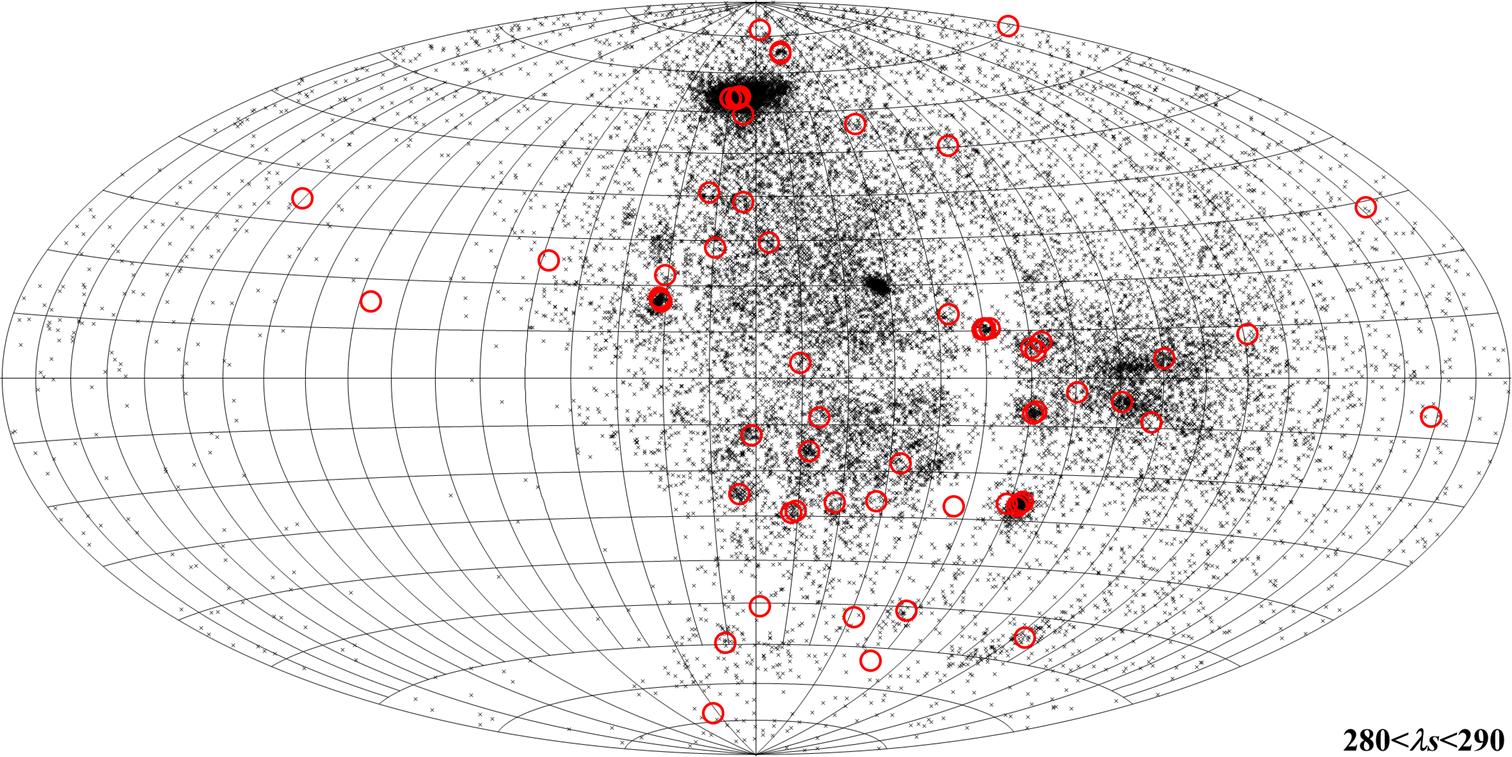
Figure 35 – Radiant distribution obtained by the Global Meteor Network during the interval 280° < λʘ < 290°, the black crosses are the individual GMN radiants, the red circles the radiants according to the IAU shower database.
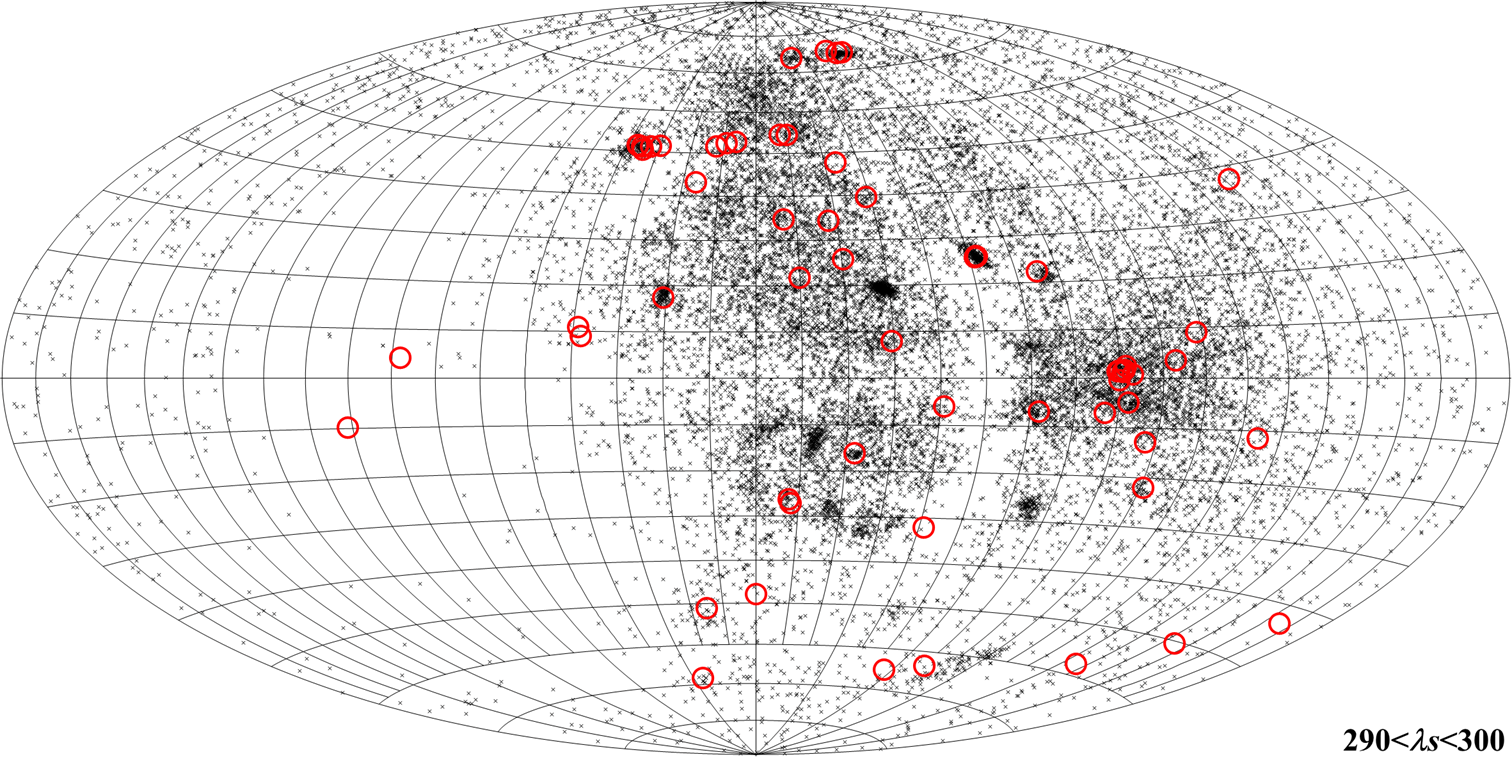
Figure 36 – Radiant distribution obtained by the Global Meteor Network during the interval 290° < λʘ < 300°, the black crosses are the individual GMN radiants, the red circles the radiants according to the IAU shower database.
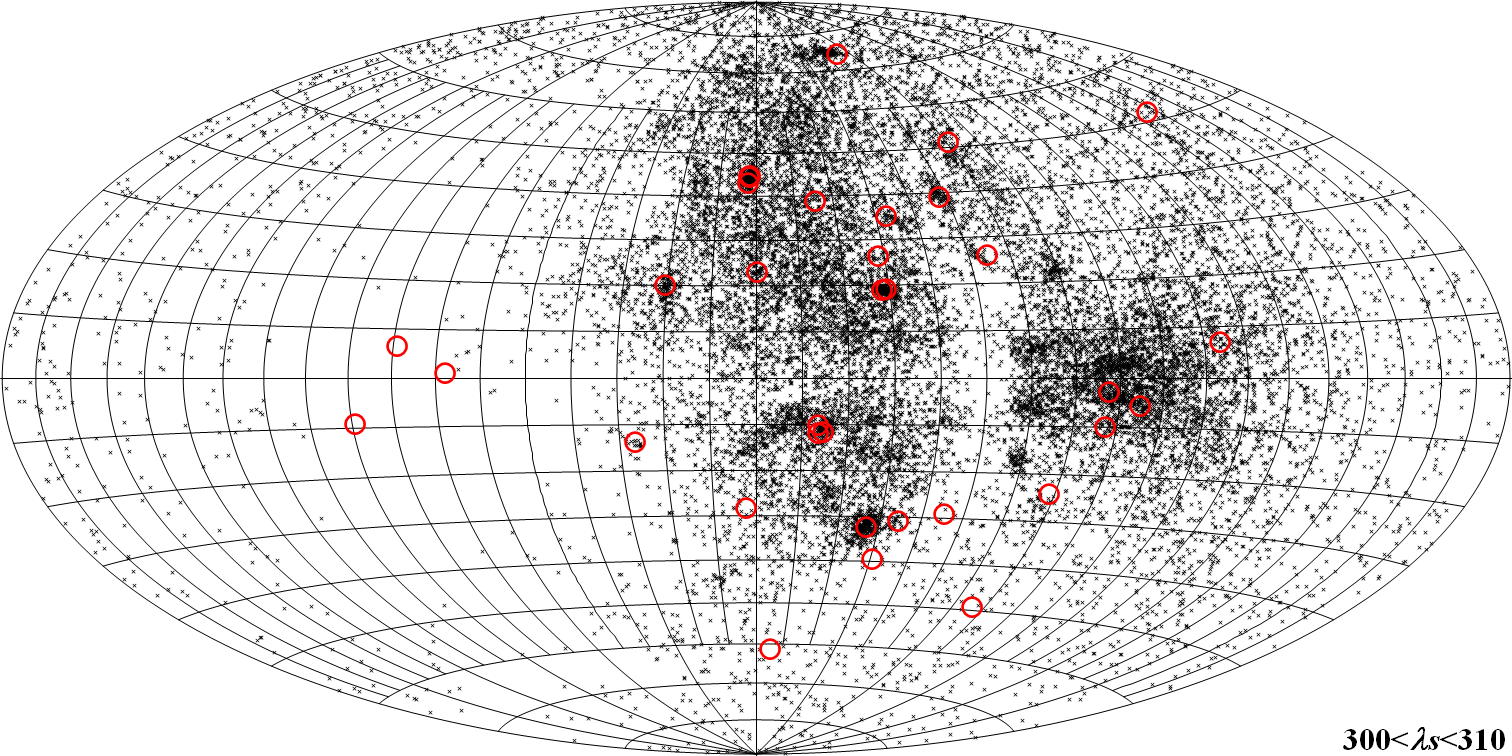
Figure 37 – Radiant distribution obtained by the Global Meteor Network during the interval 300° < λʘ < 310°, the black crosses are the individual GMN radiants, the red circles the radiants according to the IAU shower database.
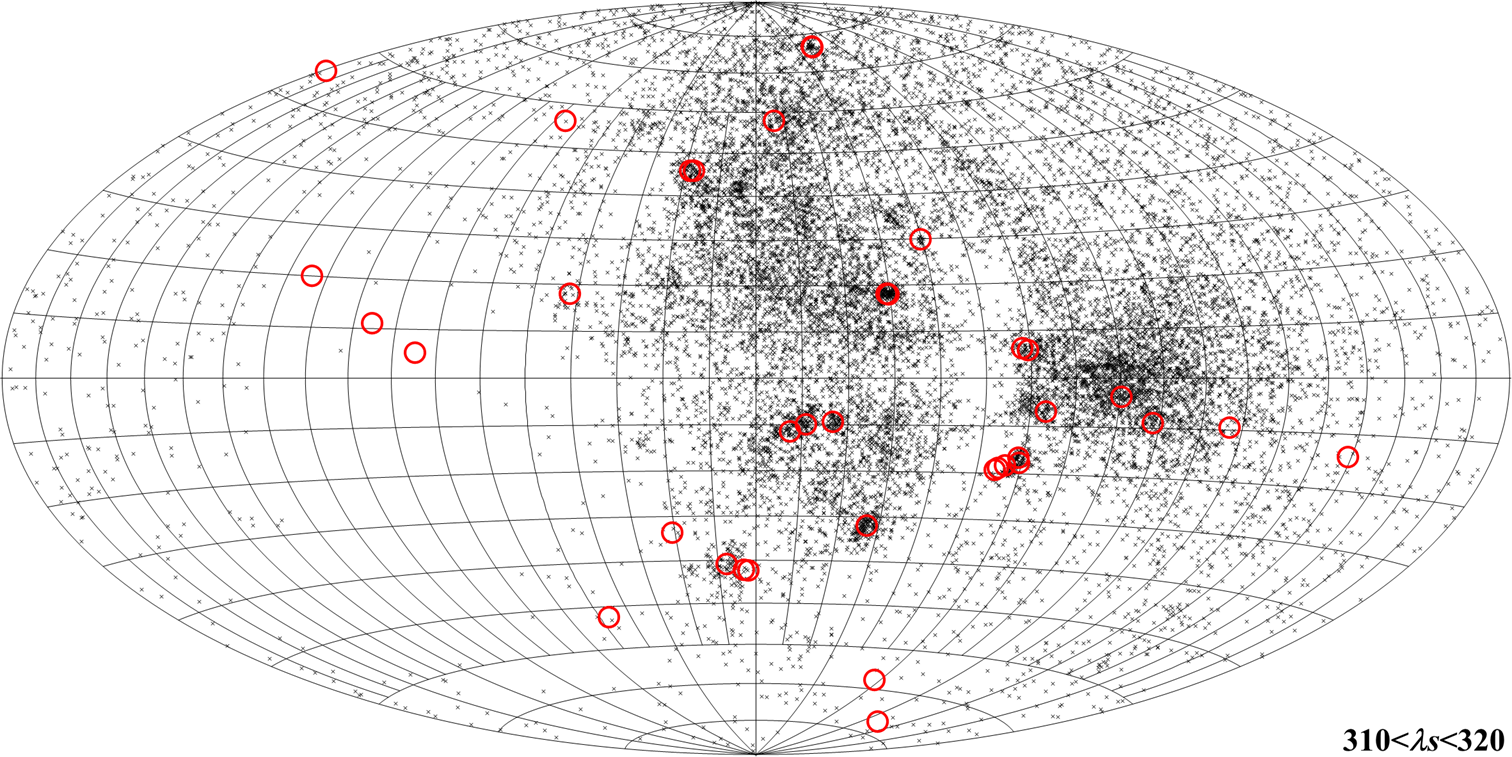
Figure 38 – Radiant distribution obtained by the Global Meteor Network during the interval 310° < λʘ < 320°, the black crosses are the individual GMN radiants, the red circles the radiants according to the IAU shower database.
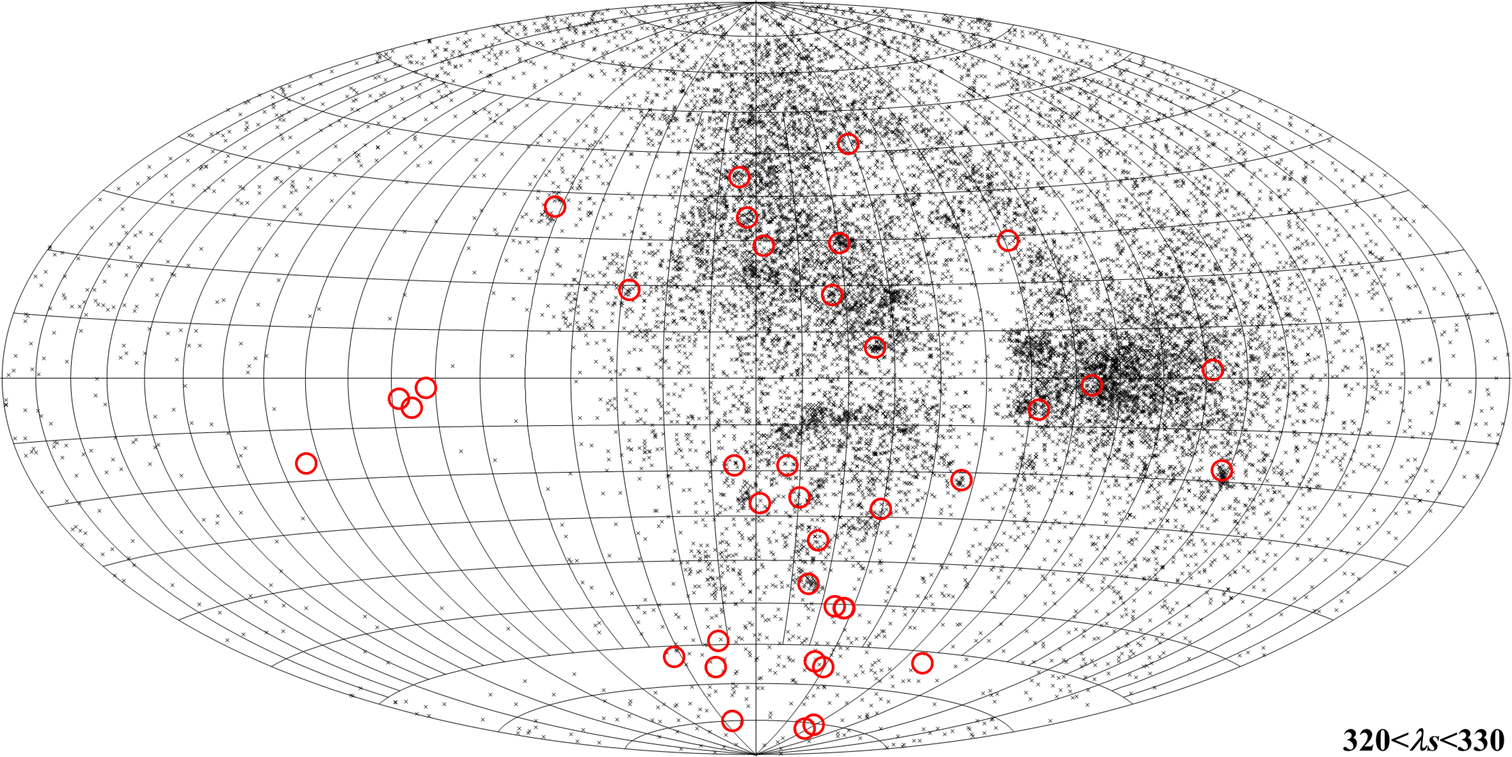
Figure 39 – Radiant distribution obtained by the Global Meteor Network during the interval 320° < λʘ < 330°, the black crosses are the individual GMN radiants, the red circles the radiants according to the IAU shower database.
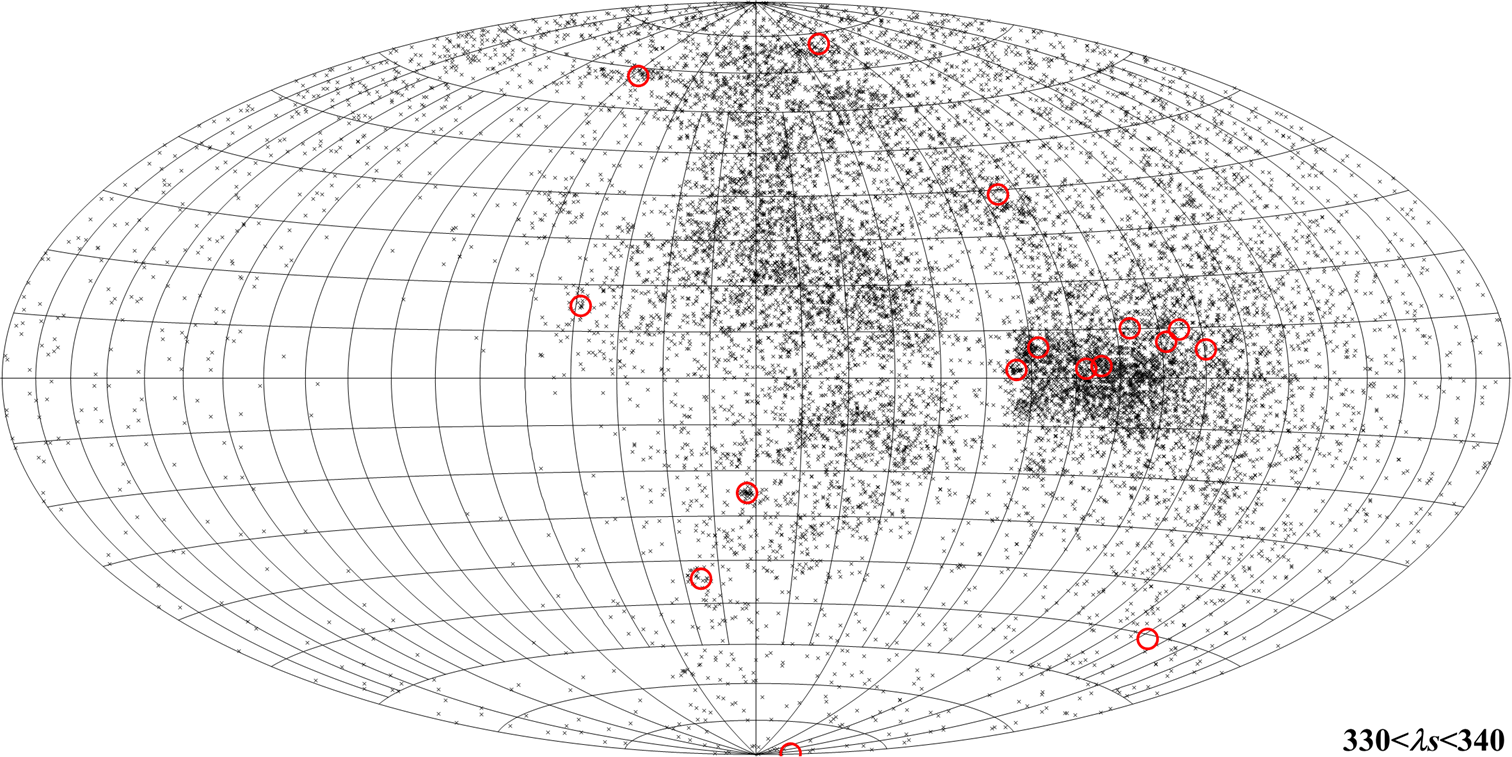
Figure 40 – Radiant distribution obtained by the Global Meteor Network during the interval 330° < λʘ < 340°, the black crosses are the individual GMN radiants, the red circles the radiants according to the IAU shower database.
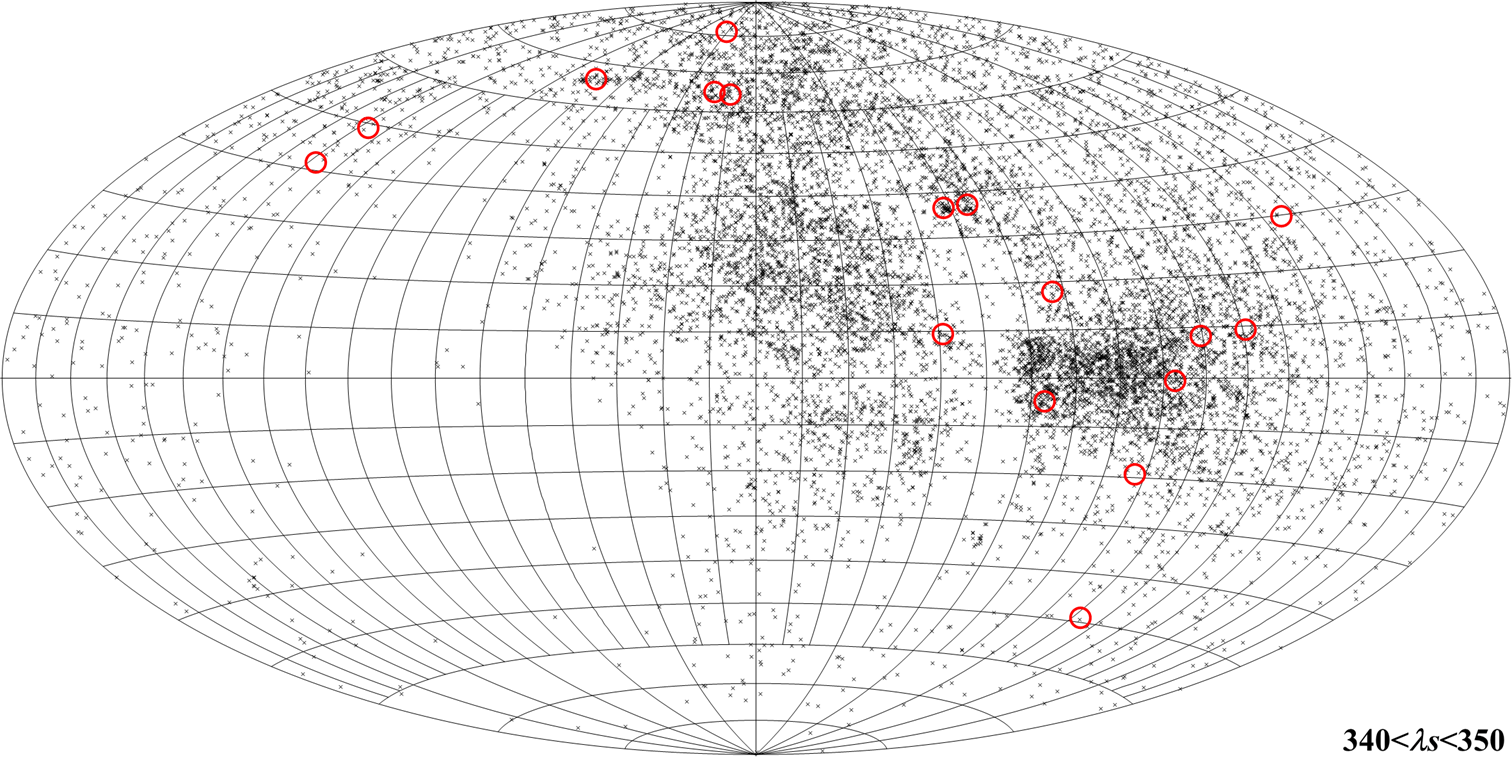
Figure 41 – Radiant distribution obtained by the Global Meteor Network during the interval 340° < λʘ < 350°, the black crosses are the individual GMN radiants, the red circles the radiants according to the IAU shower database.
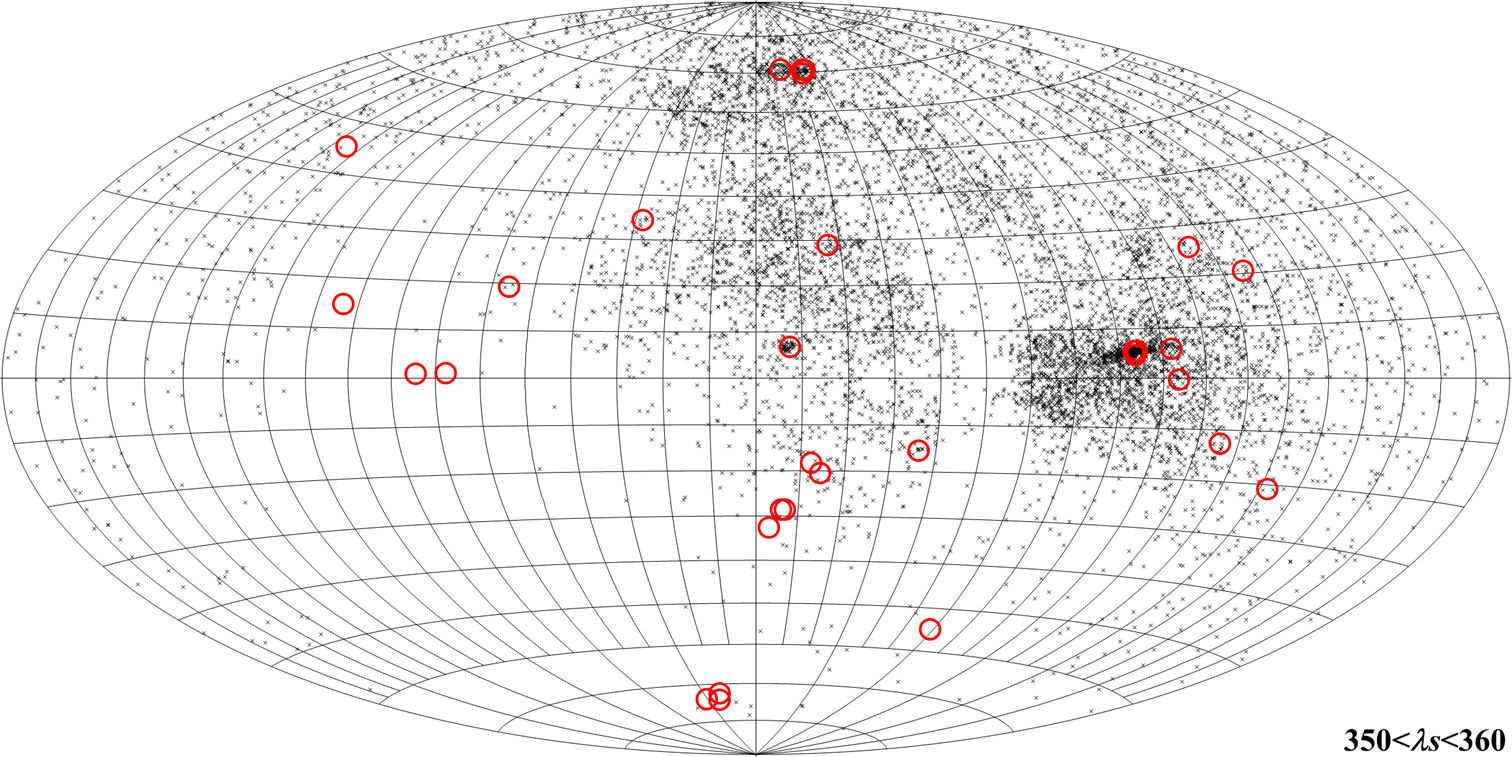
Figure 42 – Radiant distribution obtained by the Global Meteor Network during the interval 350° < λʘ < 360°, the black crosses are the individual GMN radiants, the red circles the radiants according to the IAU shower database.

